Twos to Nines Challenges
This blog post contains Amazon affiliate links. As an Amazon Associate, I earn a small commission from qualifying purchases.
Looking for a fun, math-y first day of school activity? These Order of Operations Challenges are one of my favorite ways to engage students on the first day of class!
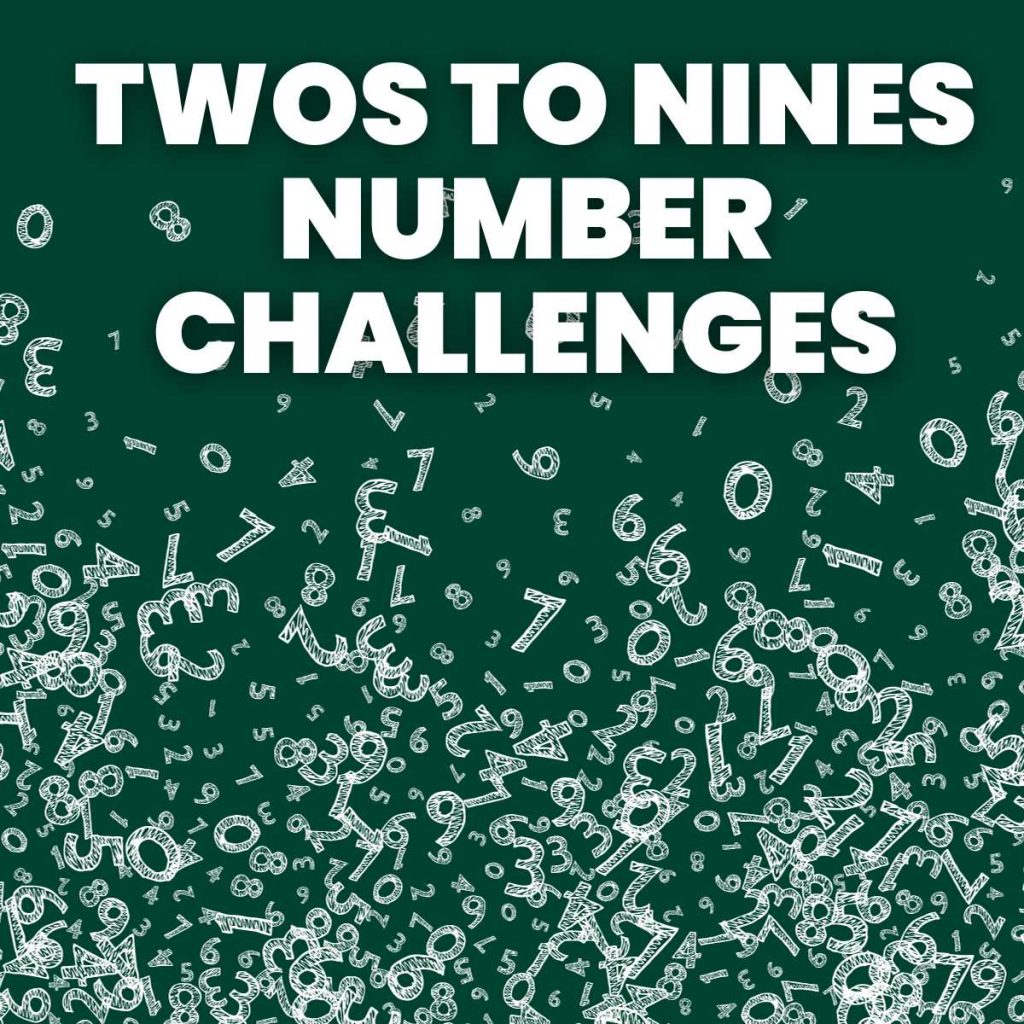
This puzzle is just one of many free printable number challenges that I have created for my own classroom and am sharing with you!
Be sure to check out my entire collection of free printable math puzzles.
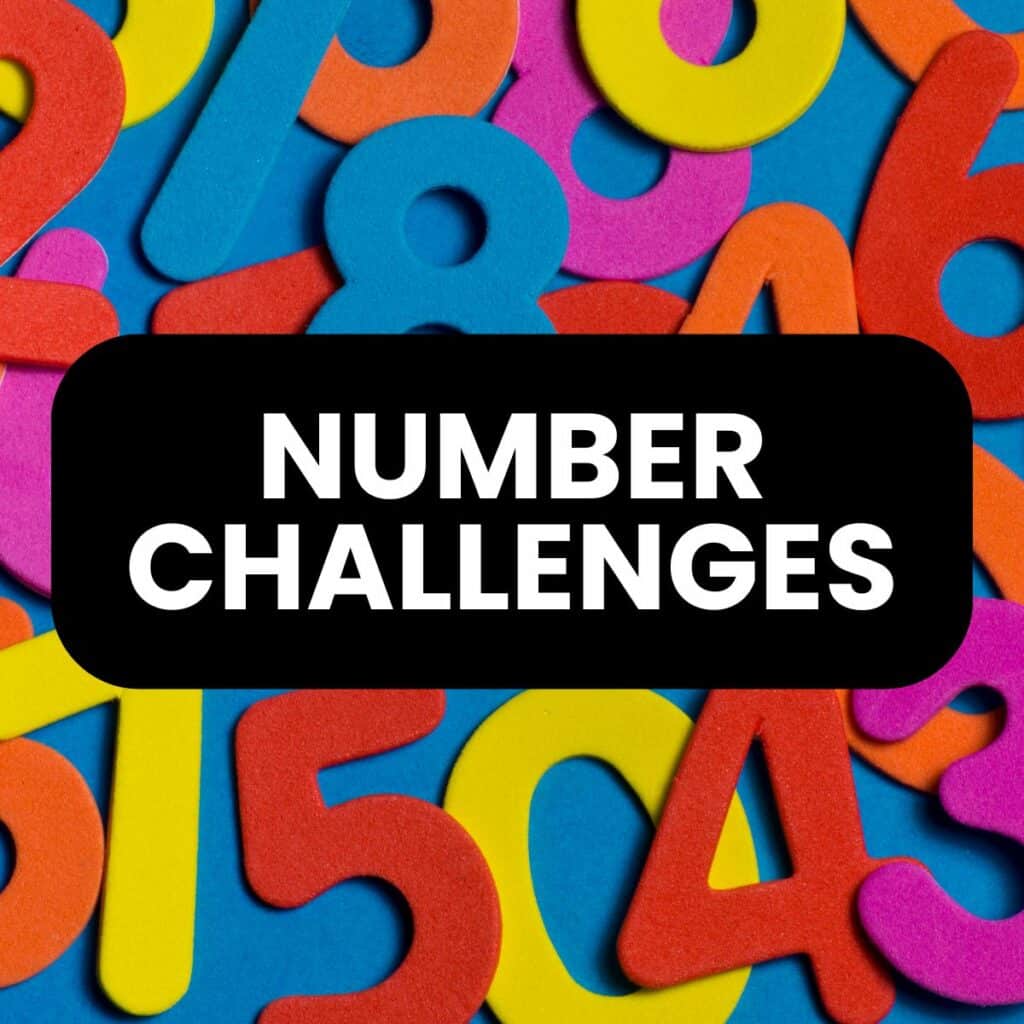
Looking for more first day of school activities and puzzles for your classroom? I have a giant blog post dedicated to 40+ activities for the first week of school.
Here’s a few examples of some of these engaging activities for the beginning of the school year.
Activity Source
This summer, my husband and I ran across a treasure trove of puzzle books at Goodwill. We *had* to buy them. As Shaun was driving us home, I flipped through the books and would occasionally pose puzzles for us to solve together in the car. We had a lot of fun with this, and in the process I found some puzzles that would be PERFECT for use in the classroom.
One of my favorite new puzzle books from this Goodwill trip is 100 Numerical Games by Pierre Berloquin. If you don’t believe me that this book is awesome, just take a look at who wrote the foreword. THE Martin Gardner!
One particular set of puzzles which is sprinkled throughout the book really caught my eye. This version was based on the number two, but the book also featured puzzles for the numbers three through nine.
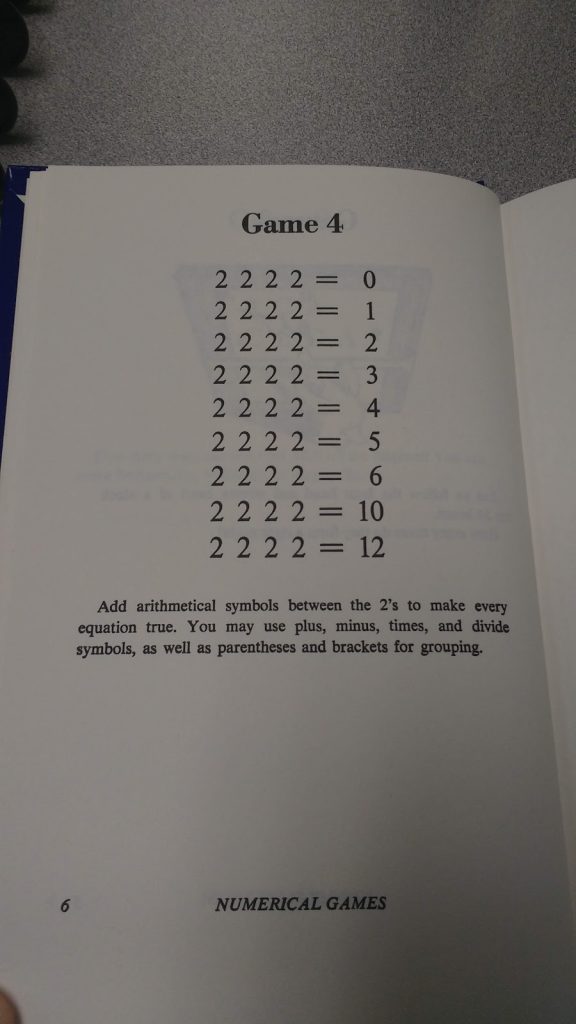
Twos to Nines Challenge Instructions
The task is to use exactly four twos (or threes, fours, etc) to make each target number. Add arithmetical symbols between the numbers to make every equation true. You may use plus, minus, times, and divide symbols, as well as parentheses and brackets for grouping.
Turning this Into a First Day of School Activity
Originally, I thought about turning this into a puzzle for my puzzle table, but I never got around to it. Fast forward to this past week. I needed an activity to do on day one, and I decided I wanted to do something a bit different than what I’ve done in the past.
For reference on past activities, check out my post on 40+ Ideas for the First Week of School!
One of the messages I communicate to my students on the first day of school is that we do math everyday. I can’t just say this. I also have to give them math to do on day one.
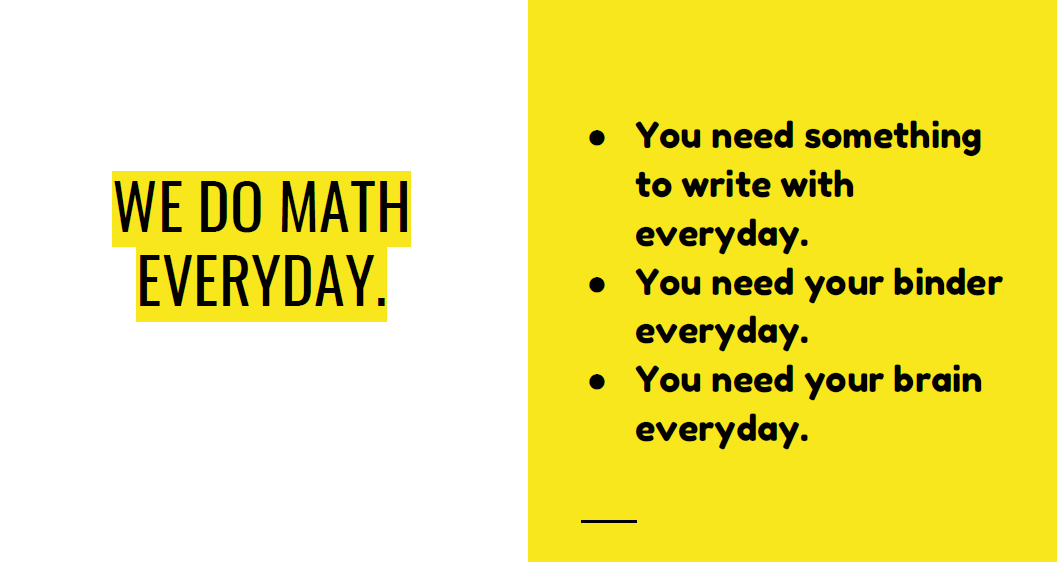
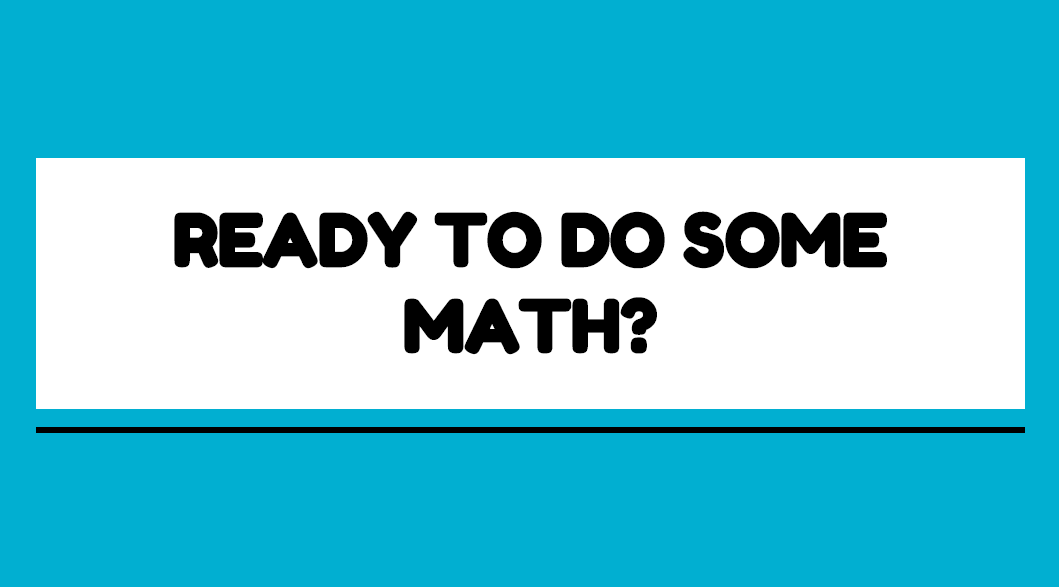
Yes, there were some groans. We carried on anyway.
My students are arranged in six groups of five, so I decided to set up six challenges around the room. The book featured challenges using the numbers between 2 and 9, so this meant that I had not used the challenges based on the numbers 8 and 9.
Introducing Students to the Challenge
To introduce the task, I threw the Eights Challenge up on the TV. (It’s going to take me a while to get used to saying TV and not SMARTBoard!)
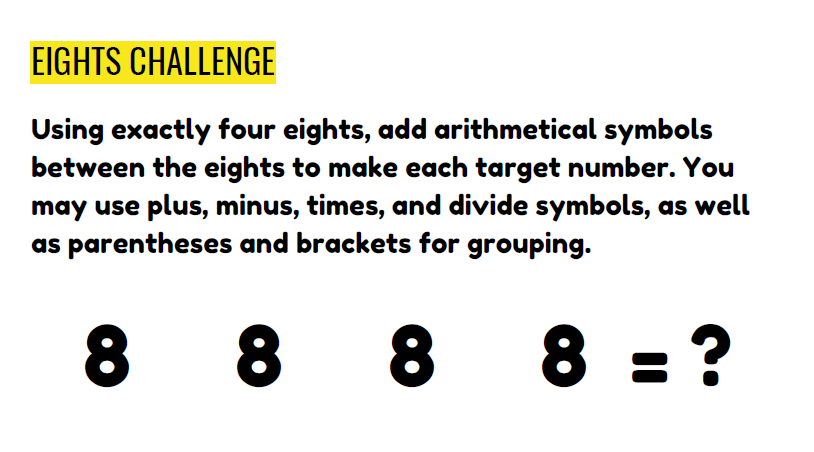
After a quick overview of the rules, I gave them a few target numbers to work towards.
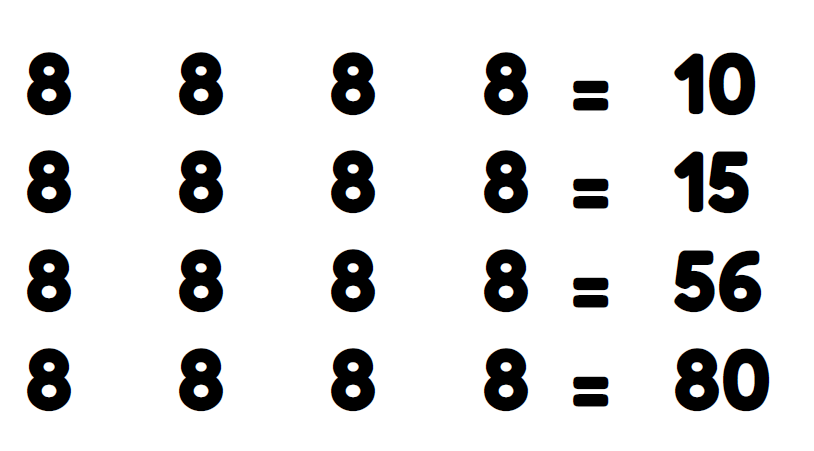
Students quickly got to work. Some grabbed paper and a writing utensil. Others got out their graphing calculator or phone calculator. Still others just sat and thought about the task.
Within a couple of minutes, a student in each period would announce that they had found the answer to 10. I asked them to read me their solution so I could write it on the board.
Almost every single time, I ended up hearing 8 + 8 / 8 + 8 = 10. So, I would tell them that we needed to check their work. This was when I asked them what the order of operations says that we need to do first. Unanimously, the class would say divide. Then, a bit of panic would set in. 8/8 is 1. So, 8 + 1 + 8 is 17, not 10.
Without me saying a word, the class would start to suggest either a different way to solve the problem OR a way to salvage this attempt. It usually wasn’t long before someone would suggest that we could use PARENTHESES! So, from this, I learned that we do know our order of operations. We’re just a bit rusty, but I can deal with that.
After the class found a few of the solutions for the Eights Challenges, I decided to change things up a bit. I told them that now that they understood how the puzzle’s structure worked, it was time to try it on their own.

Around the Room Puzzle Stations
Around the room, I had marked off six four-foot sections of white board space so that each group of students could have their own space for working problems throughout the year.
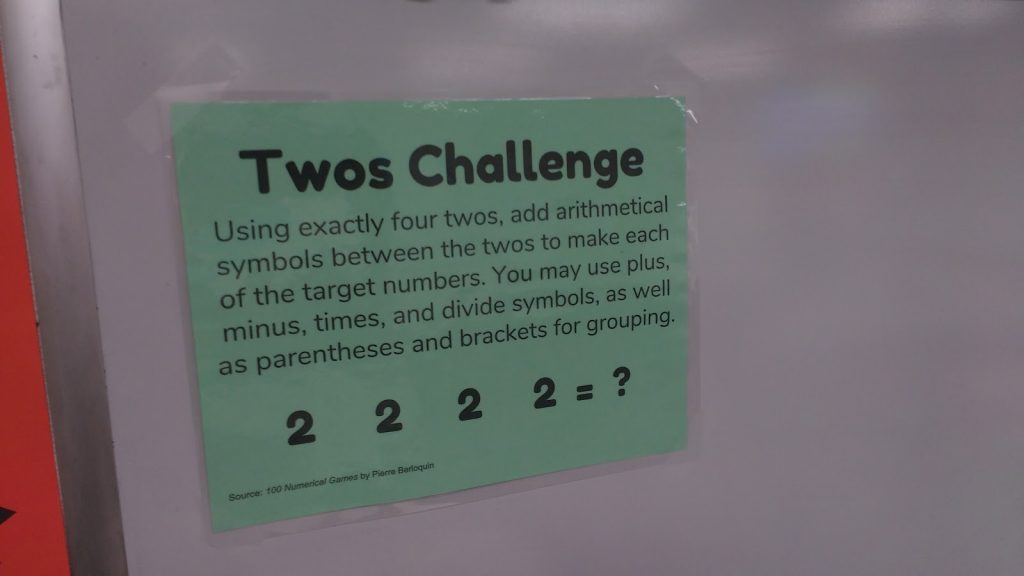
At each station, I had posted a challenge based on a different number.
I typed up the instructions for each challenge. My students didn’t really need this since we had done part of the eights challenge as an example, but I did see a few groups reference it. One group used their dry erase marker to actually write symbols between the numbers. Good thing I laminated them!
MATH = LOVE RECOMMENDS…

A laminator is a MUST-HAVE for me as a math teacher! I spent my first six years as a teacher at a school with a broken laminator, so I had to find a way to laminate things myself.
I’ve had several laminators over the years. I currently use a Scotch laminator at home and a Swingline laminator at school.
I highly recommend splurging a bit on the actual laminator and buying the cheapest laminating pouches you can find!
Then, I typed up the target numbers that students had to find. I thought about making them into magnets so the students could move the target numbers around, but I wasn’t sure where all my magnets were. Let’s just say that moving classrooms sucks. I can’t find anything right now!
I ended up just taping them to the dry erase board. This worked just fine. Most groups left the numbers stationary and just wrote their solutions next to the appropriate number. A few groups did move the numbers around.
The tape stayed sticky, so they were able to change the number positions without any issues. Since this activity went SO well, I think I will definitely add magnets at some point.
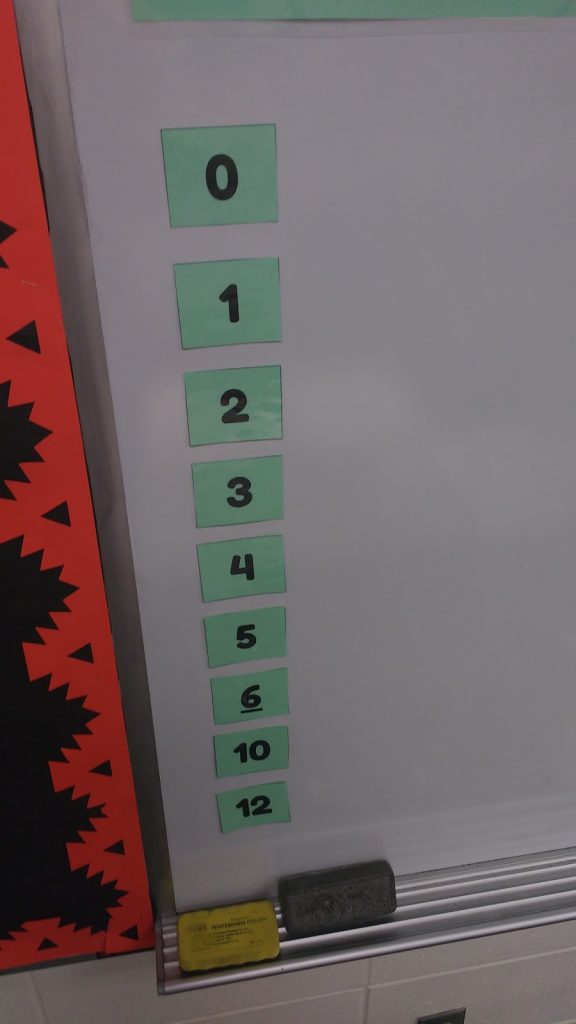
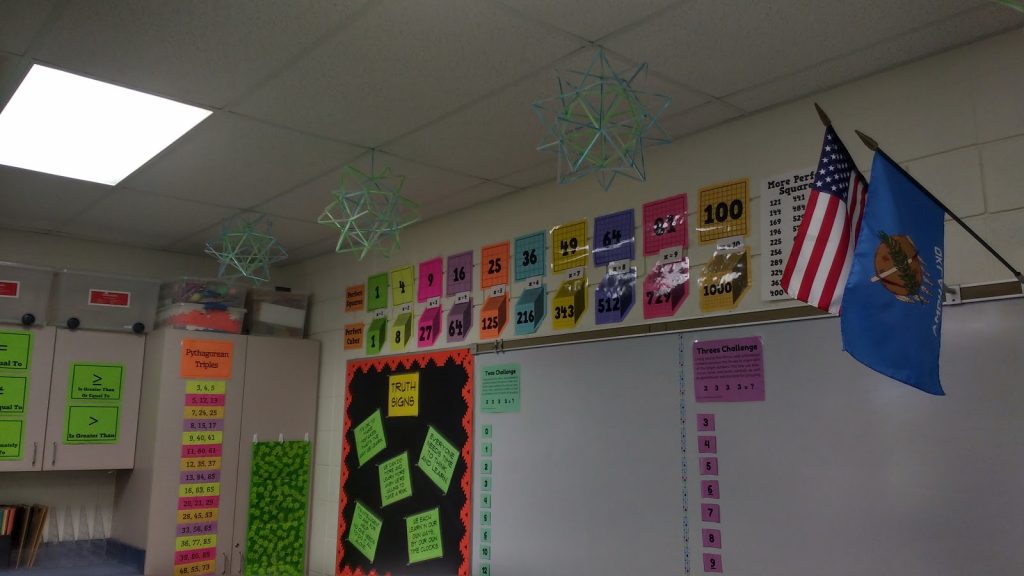
Each table group chose a different number based challenge to work on. They instantly got to work, and the room was soon abuzz with awesome conversations. Students were excited and joyful as they found various solutions.
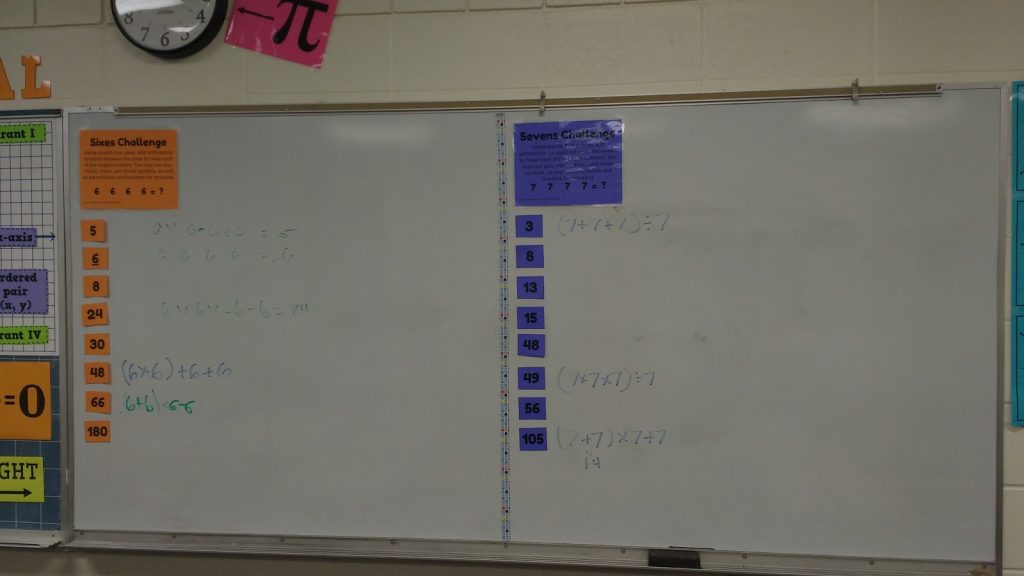
Students were checking other students’ ideas and pointing out any issues. Lots of parentheses were being used. Were all their answers perfect? Nope. But, it’s day one, and it gave me a great snapshot of where my students are starting from.
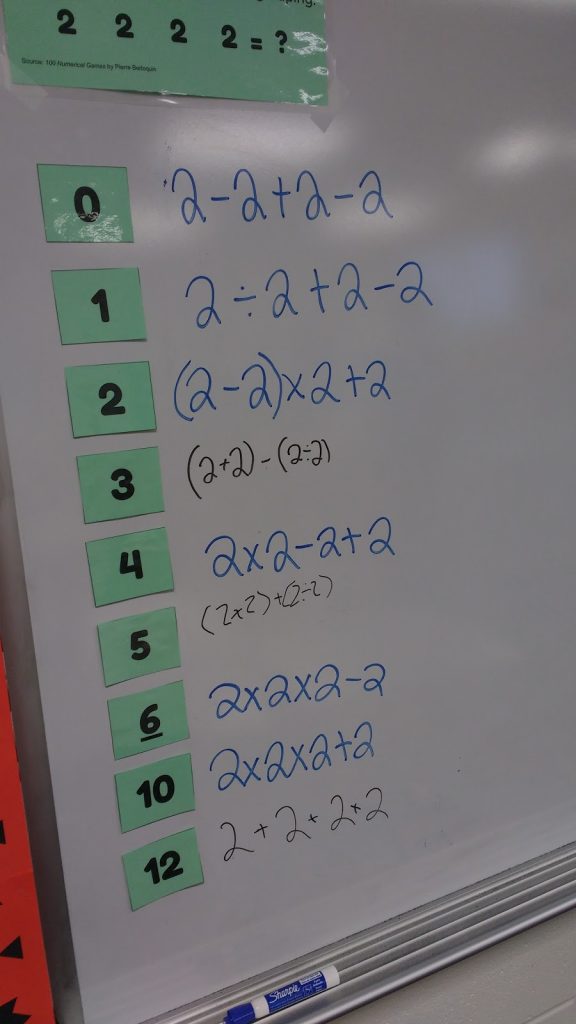
It was the first day of school and every kid was engaged. In fact, I would say this was the most engaged my students have ever been on the first day of school. This was my favorite first day of teaching EVER.
Check out this awesome group work!
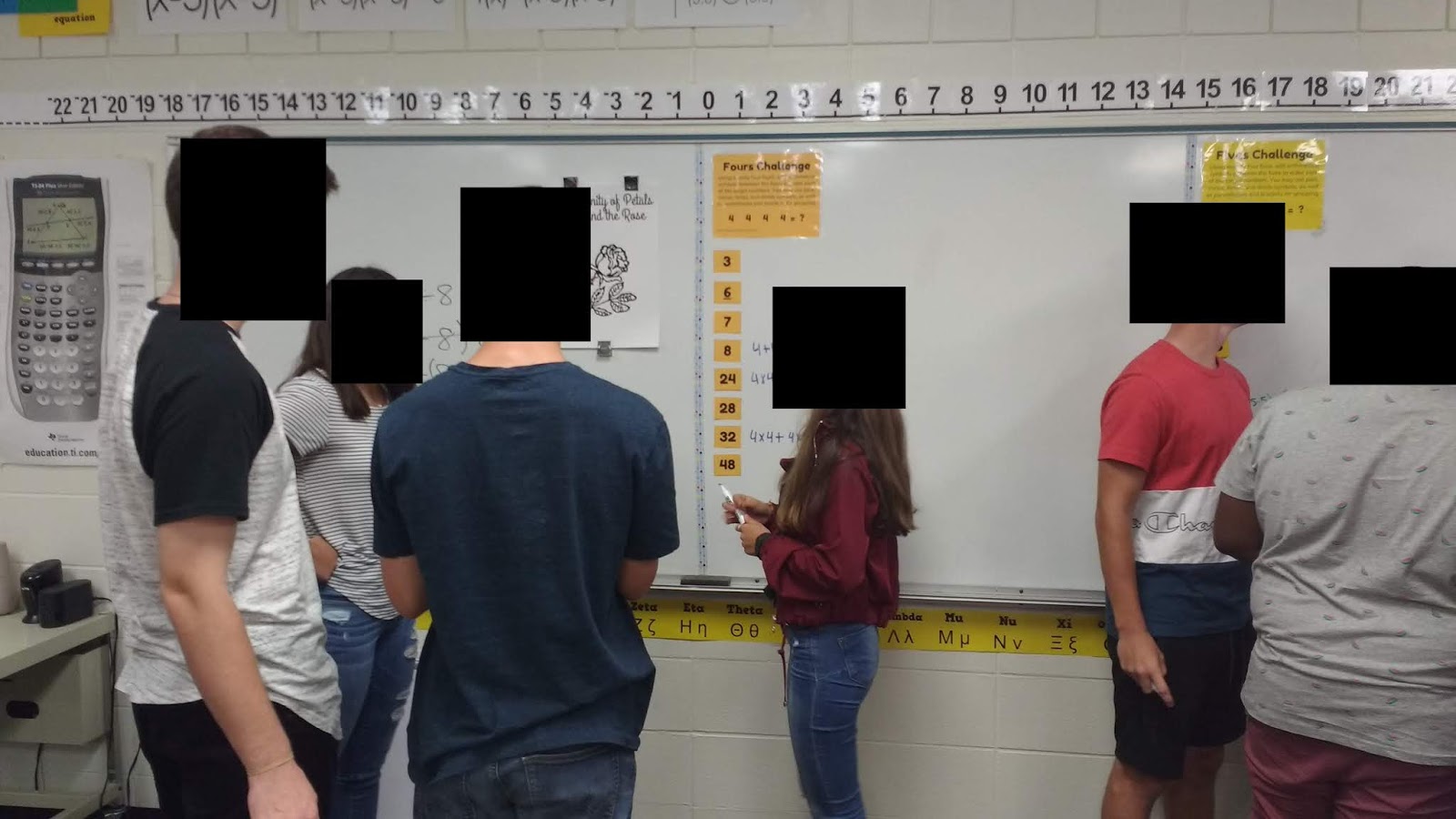
Switching Things Up
Each group was given one dry erase marker and one graphing calculator to encourage collaboration. Every few minutes, I would announce “SWITCH!” This meant that the person holding the marker needed to pass it to another person in the group. The calculator person did the same thing.
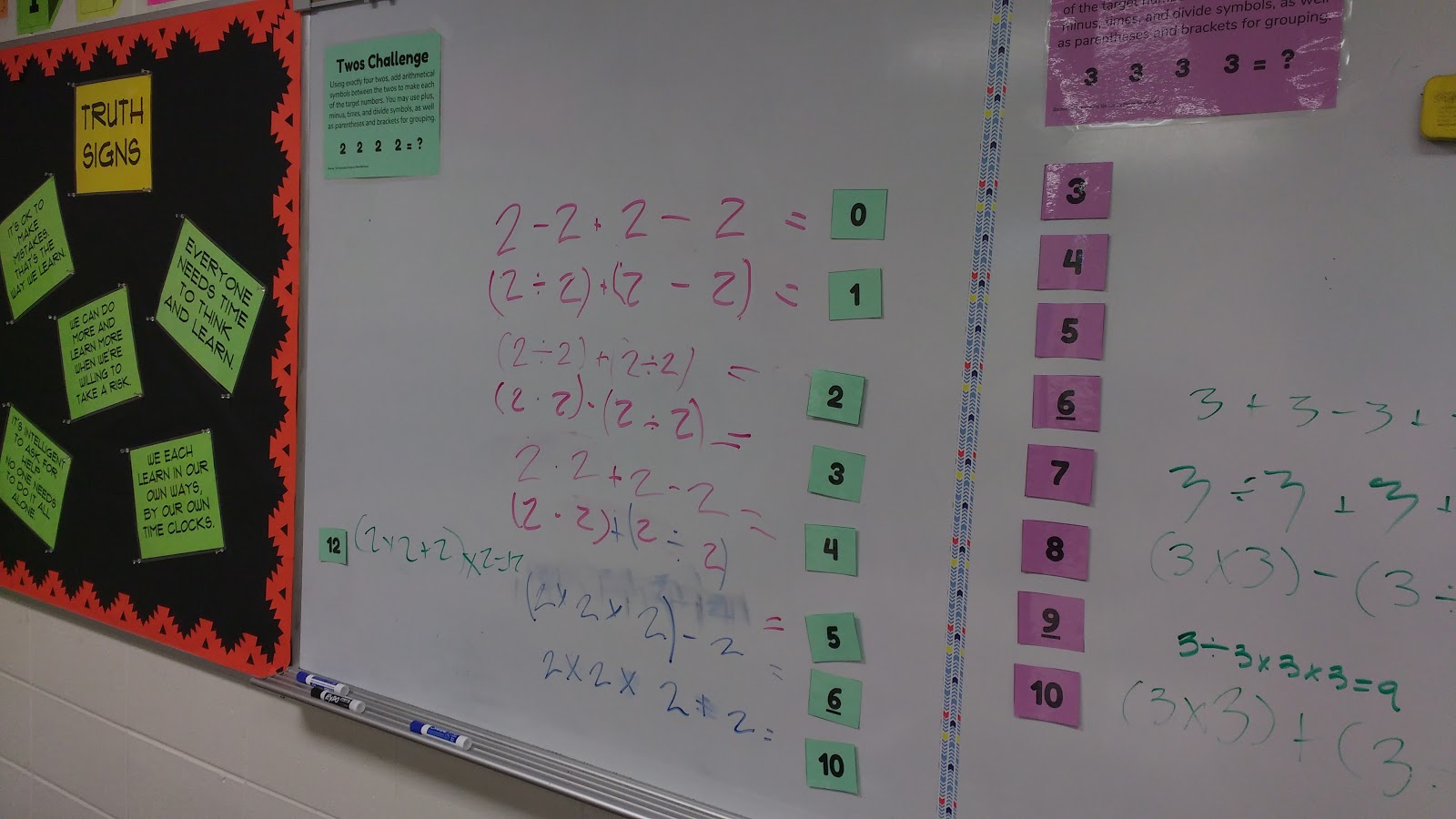
Every once in a while, I would introduce a new twist. About five minutes into the activity, I had the groups pause and look at me. I instructed them to nominate one volunteer from each group. This person was to hold their hand up so I could ensure that I had one volunteer from EVERY group. They asked what they were volunteering for. I just said “You’ll find out soon.”
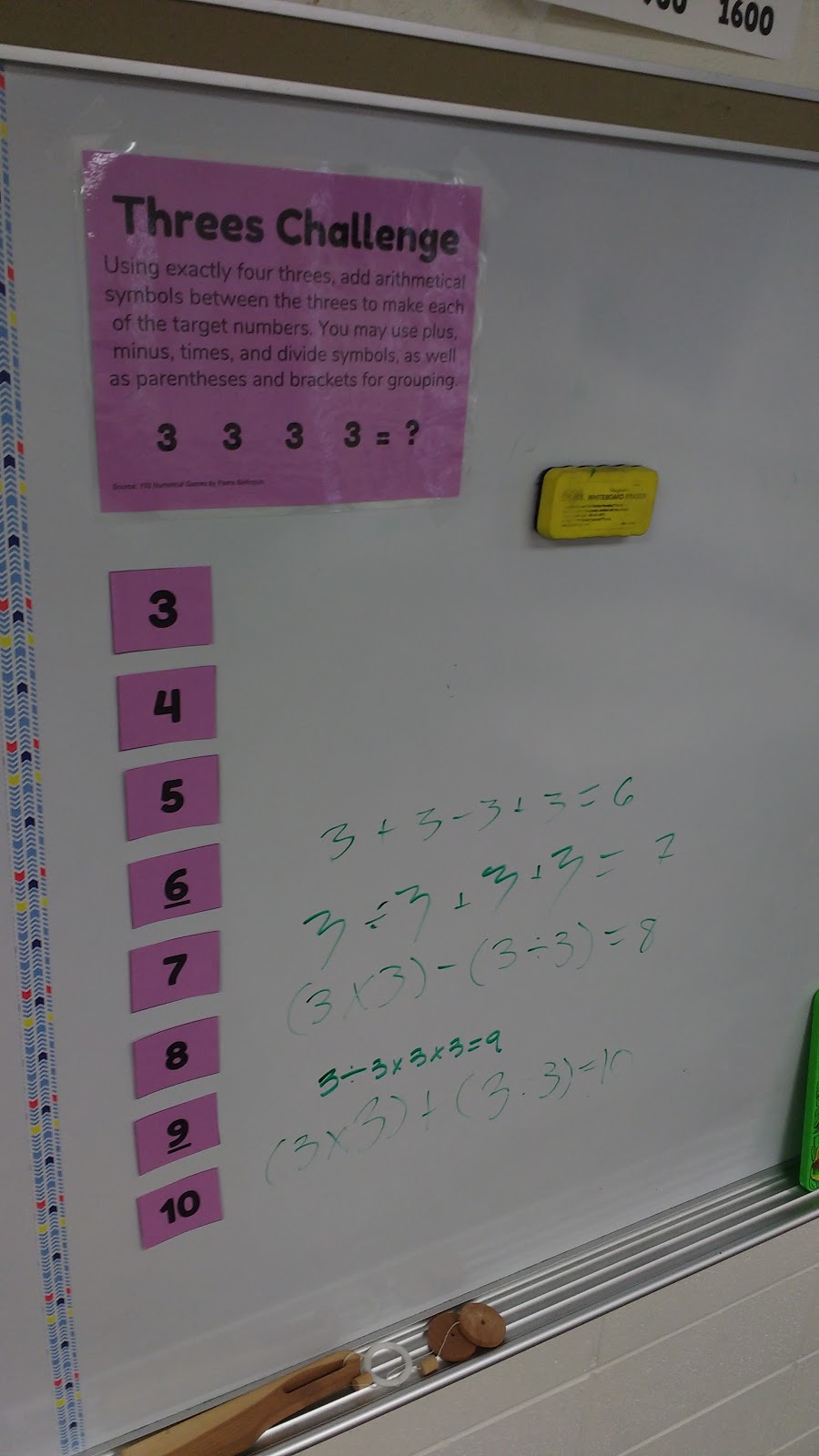
Once one hand was up from every group, I informed the class that these students would be rotating one group clock-wise. So, each group would lose one member and gain a different member. There were a few groans with this announcement, but students complied.
I was excited to try this strategy since each group was working on the same type of challenge, but no two groups had the same problems to solve. This meant that the new group member could bring STRATEGIES from their previous group, but they could not just bring ANSWERS.
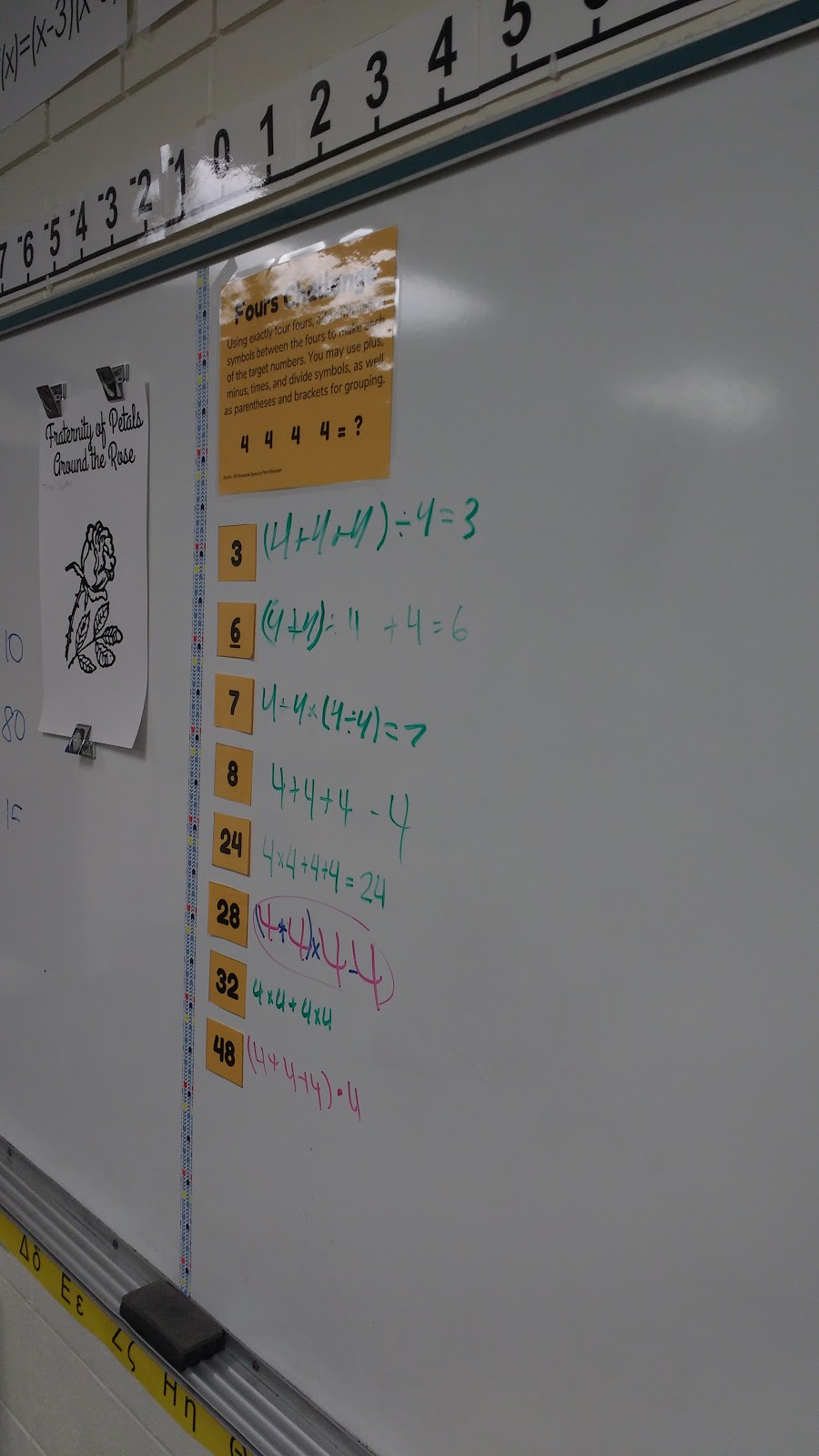
After a few times of rotating a single group member, I changed things up yet again with having the entire group rotate to the next station. I did run into a few issues that I hadn’t figured out how to handle beforehand.
What to Do When Groups Start Finishing
The groups assigned to the challenges based on lower numbers (2s, 3s, and 4s especially) were sometimes able to completely finish their challenge. When this happened, I did one of two things.
In my smaller classes, there was often a challenge that had not yet been started. In these classes, I sent the finished group to this untackled challenge. In my larger classes, I had the finished group split apart and join other groups.
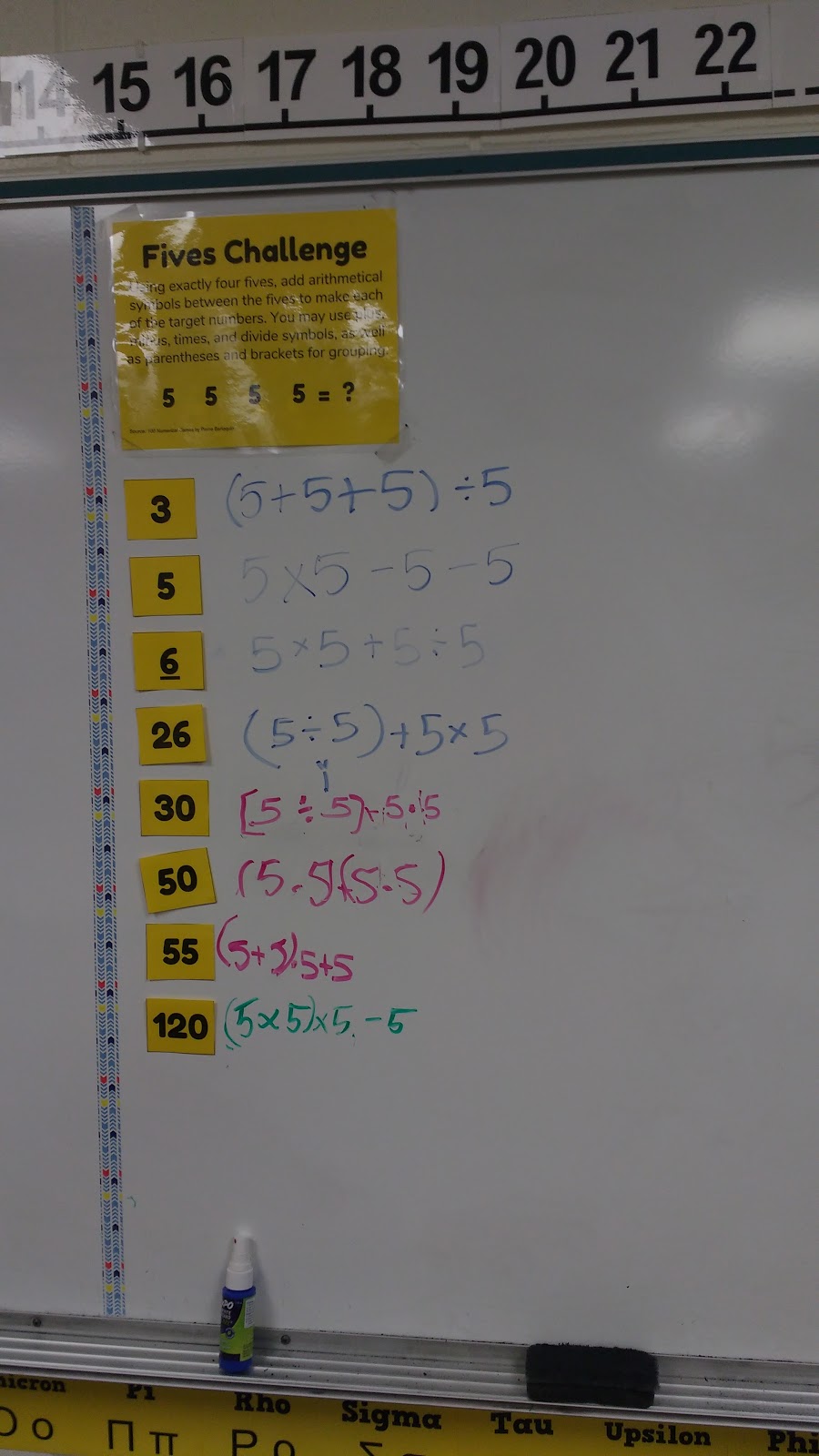
The Sevens Challenge ended up being the most difficult for my students to tackle. Often, there would only be two or three target numbers solved by the end of the class period.
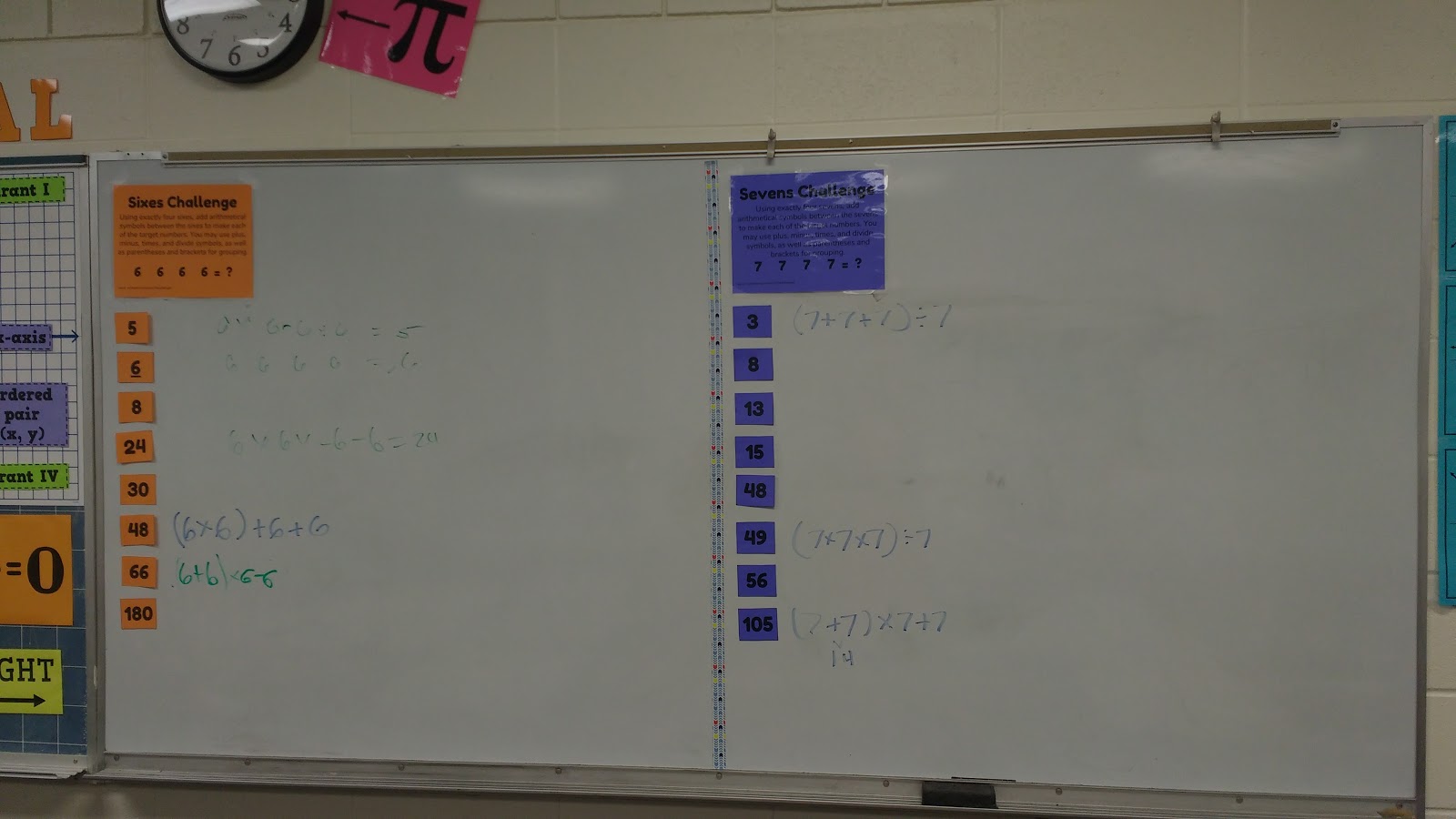
Twos to Nines Challenge Files
Want to try this activity with your own students? You can find where I typed up the challenges in two different formats: Google Slides and PDF (below). I hope your students enjoy it as much as mine! This activity had my students finding joy in solving tricky math problems. My job is done.
Click here to SAVE the file to your device.
Twos to Nines Challenges (PDF)
15304 saves – 67.05 KB
Individual Number Challenges
Don’t have time for this activity and want to experience part of the magic on a much smaller scale? I have created separate printables for each individual number challenge.
After so many teachers had success using the Twos to Nines Challenge with their students during the first week of school, I decided to turn it into a collection of free printable order of operations puzzles that can be used throughout the entire school year.
Twos Challenge
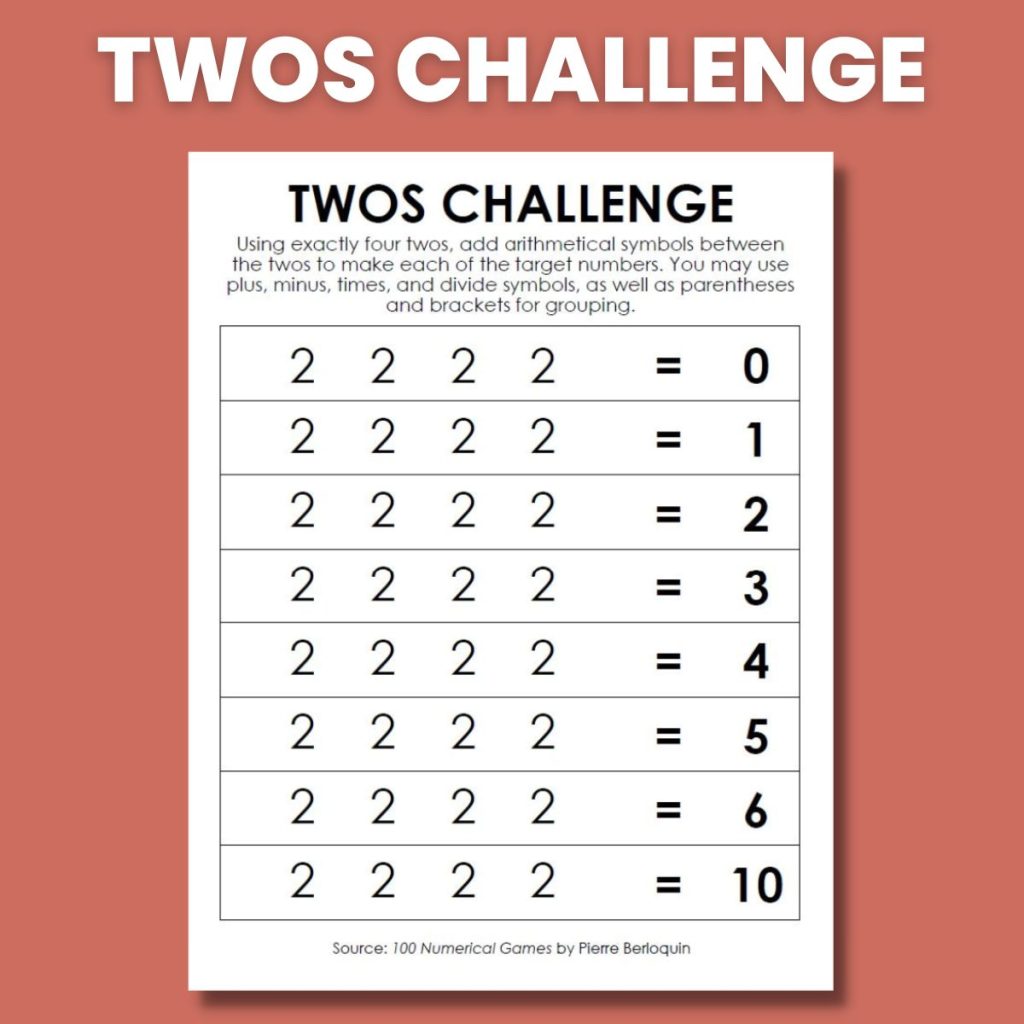
Can you solve the Twos Challenge? Can you use exactly four twos and your choice of arithmetical symbols to form the target numbers?
Threes Challenge
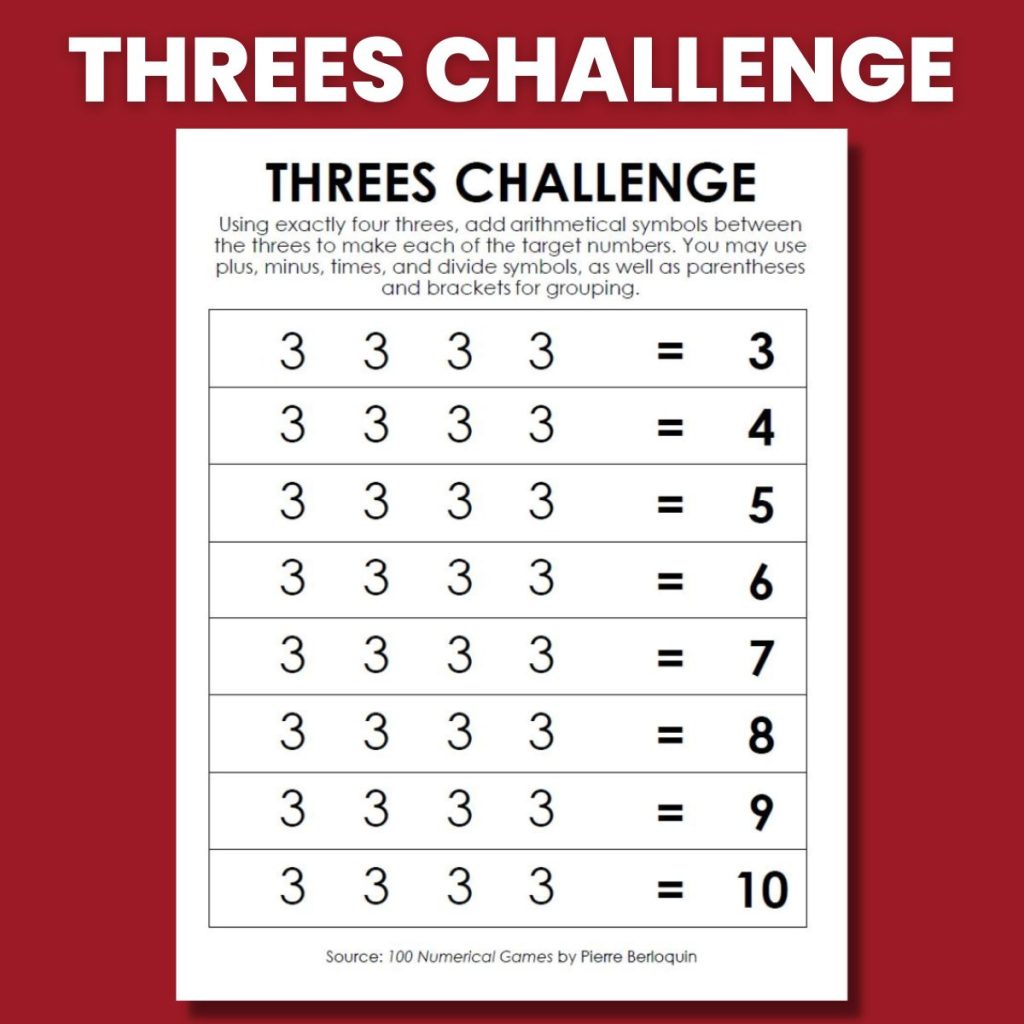
Using exactly four threes, add arithmetical symbols between the threes to make each of the target numbers. You may use plus, minus, times, and divide symbols, as well as parentheses and brackets for grouping.
Fours Challenge
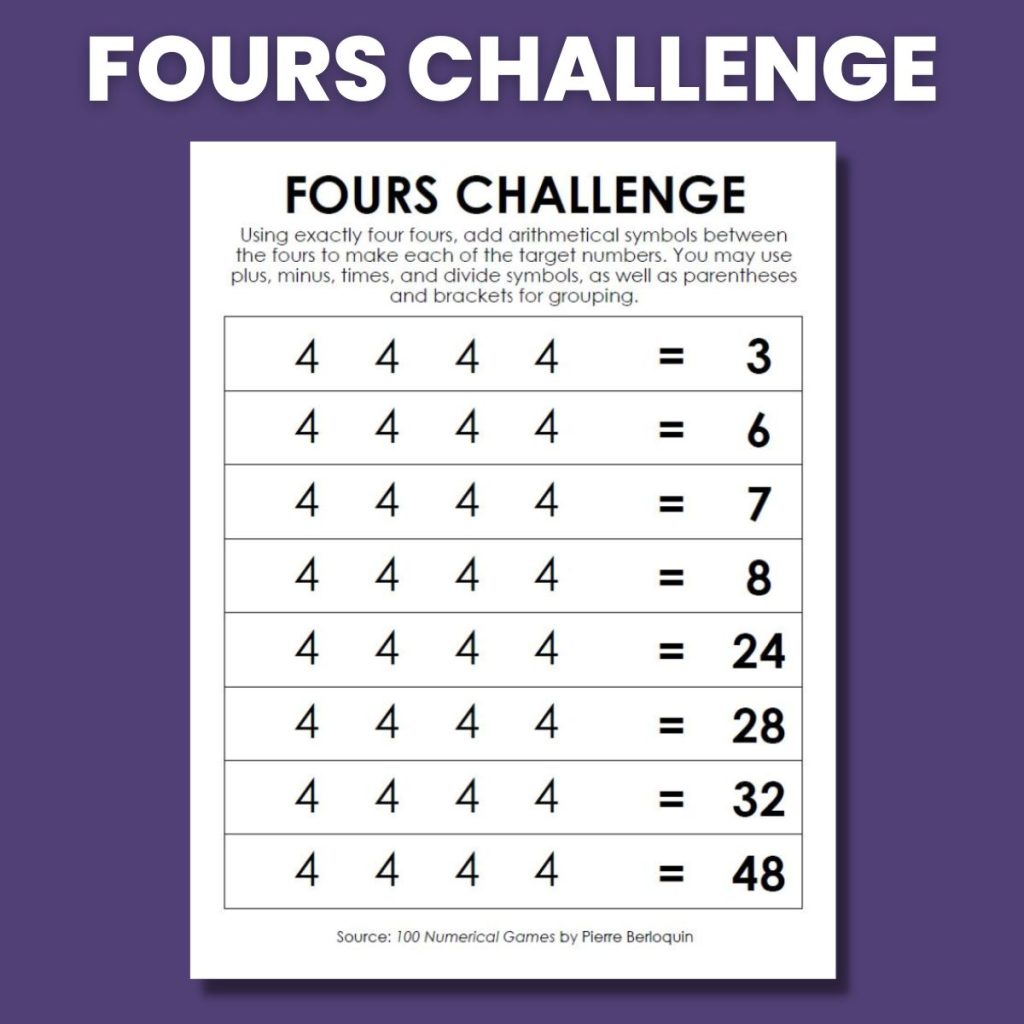
In this simplified version of the four fours challenge, students must use exactly four fours with mathematical operations to create expressions equivalent to the 8 provided numbers.
Fives Challenge
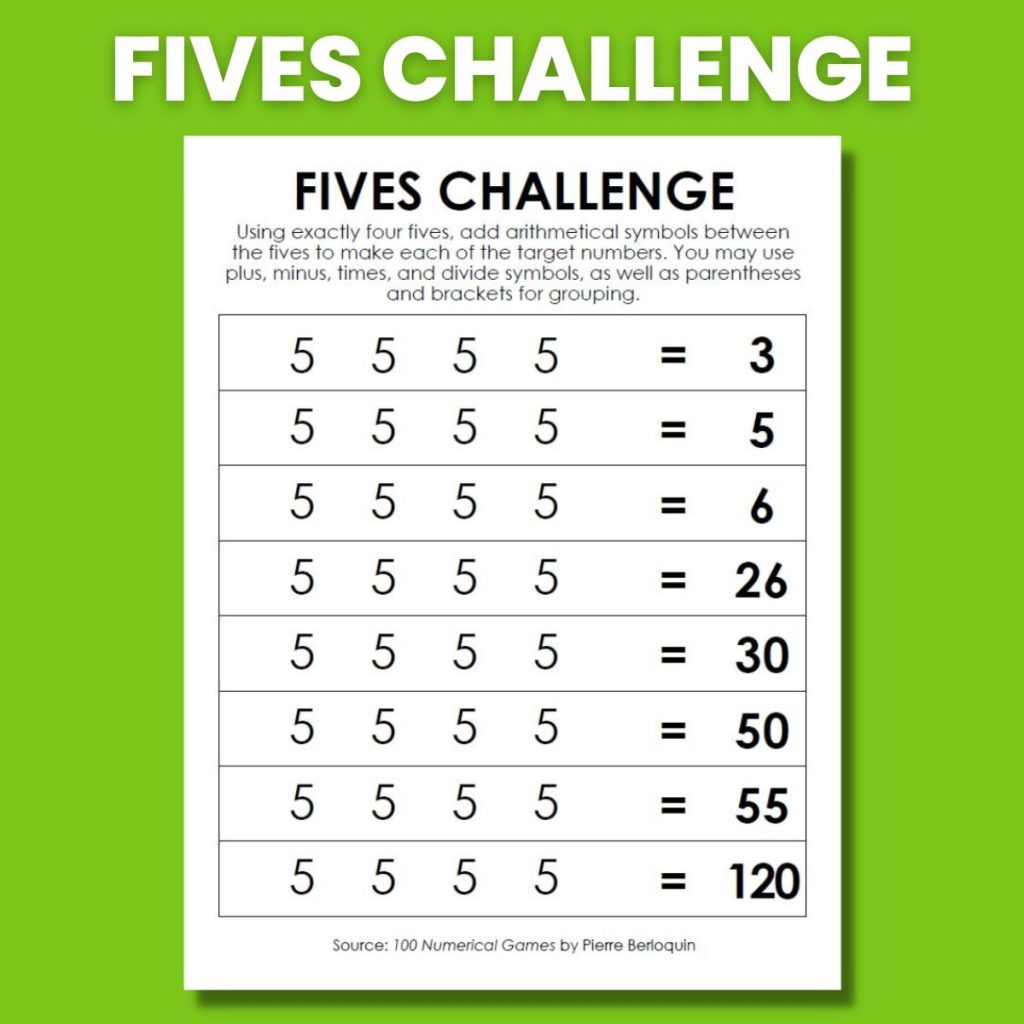
Can you solve the Fives Challenge? Can you use exactly four fives and your choice of arithmetical symbols to form the target numbers?
Sixes Challenge
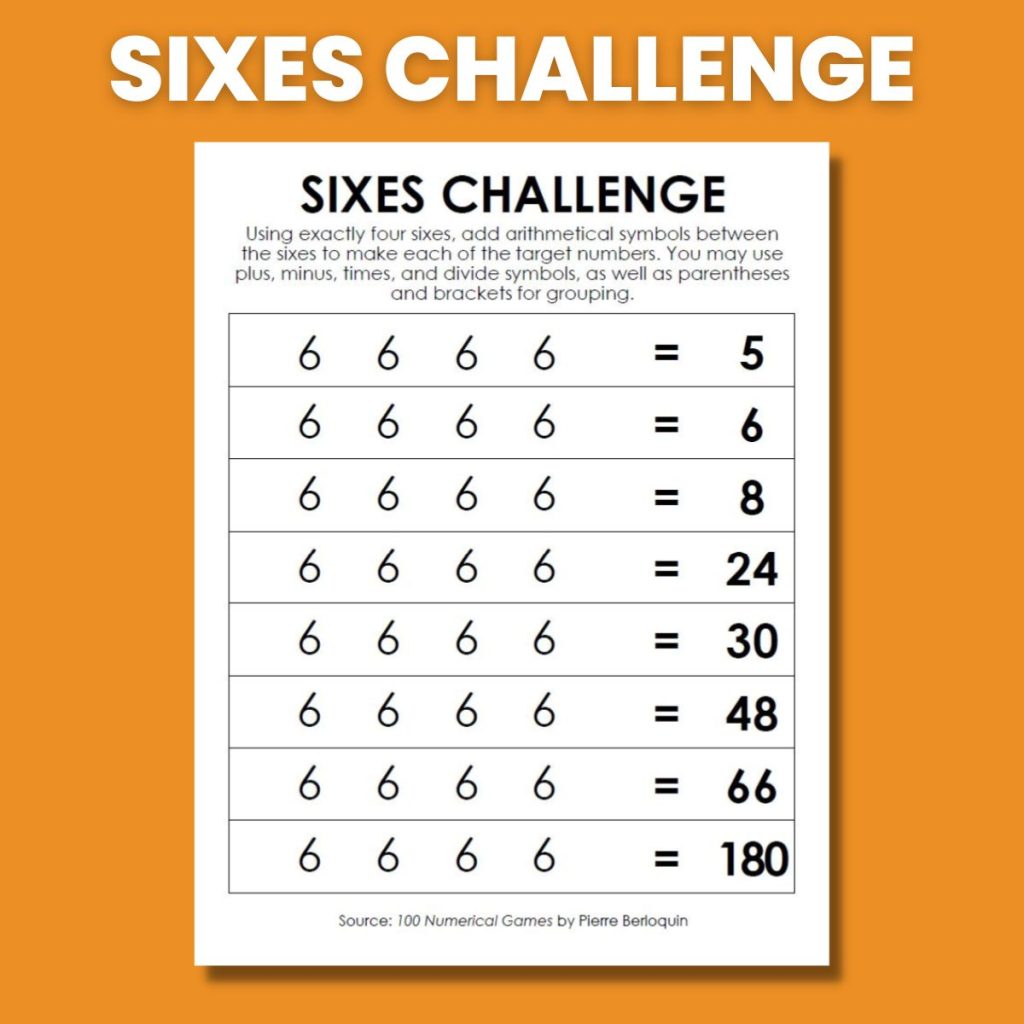
Using exactly four sixes, add arithmetical symbols between the threes to make each of the target numbers. You may use plus, minus, times, and divide symbols, as well as parentheses and brackets for grouping.
Sevens Challenge
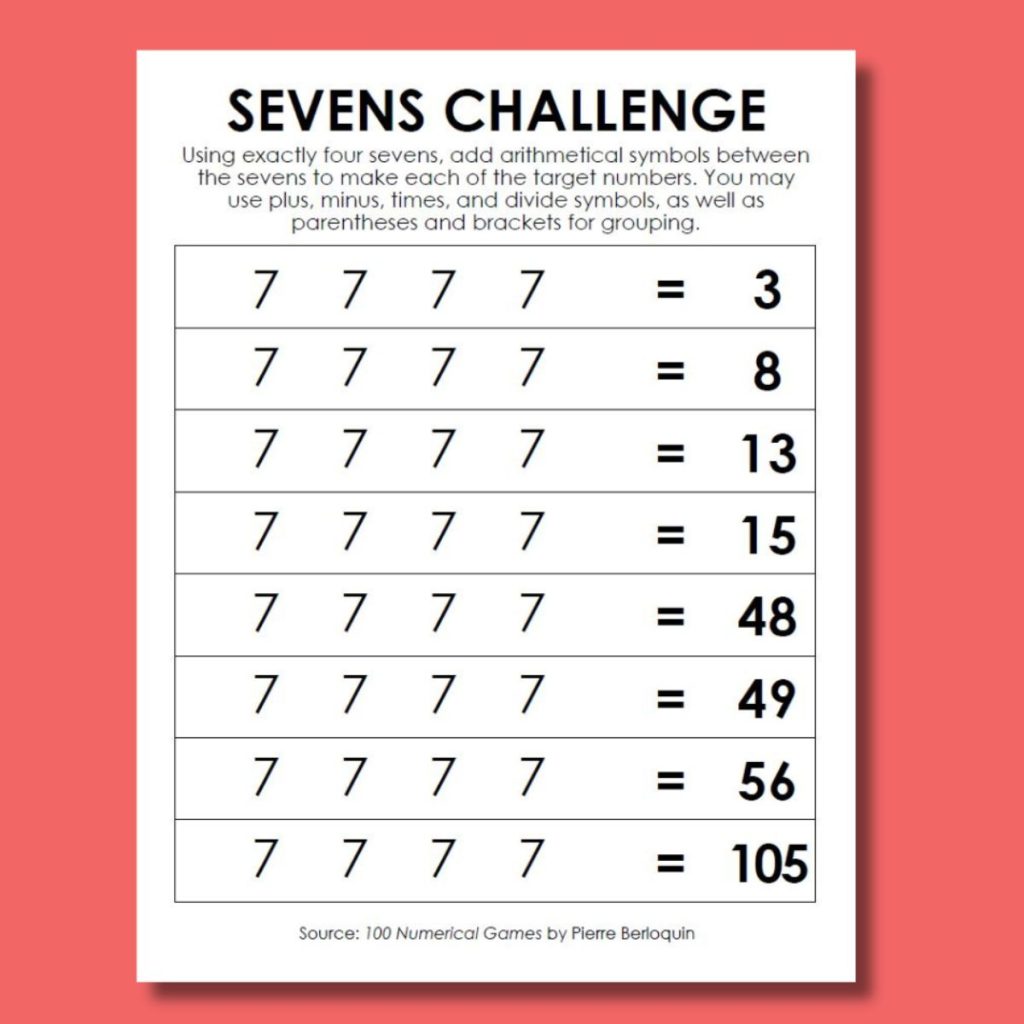
Using exactly four sevens, add arithmetical symbols between the threes to make each of the target numbers. You may use plus, minus, times, and divide symbols, as well as parentheses and brackets for grouping.
Eights Challenge
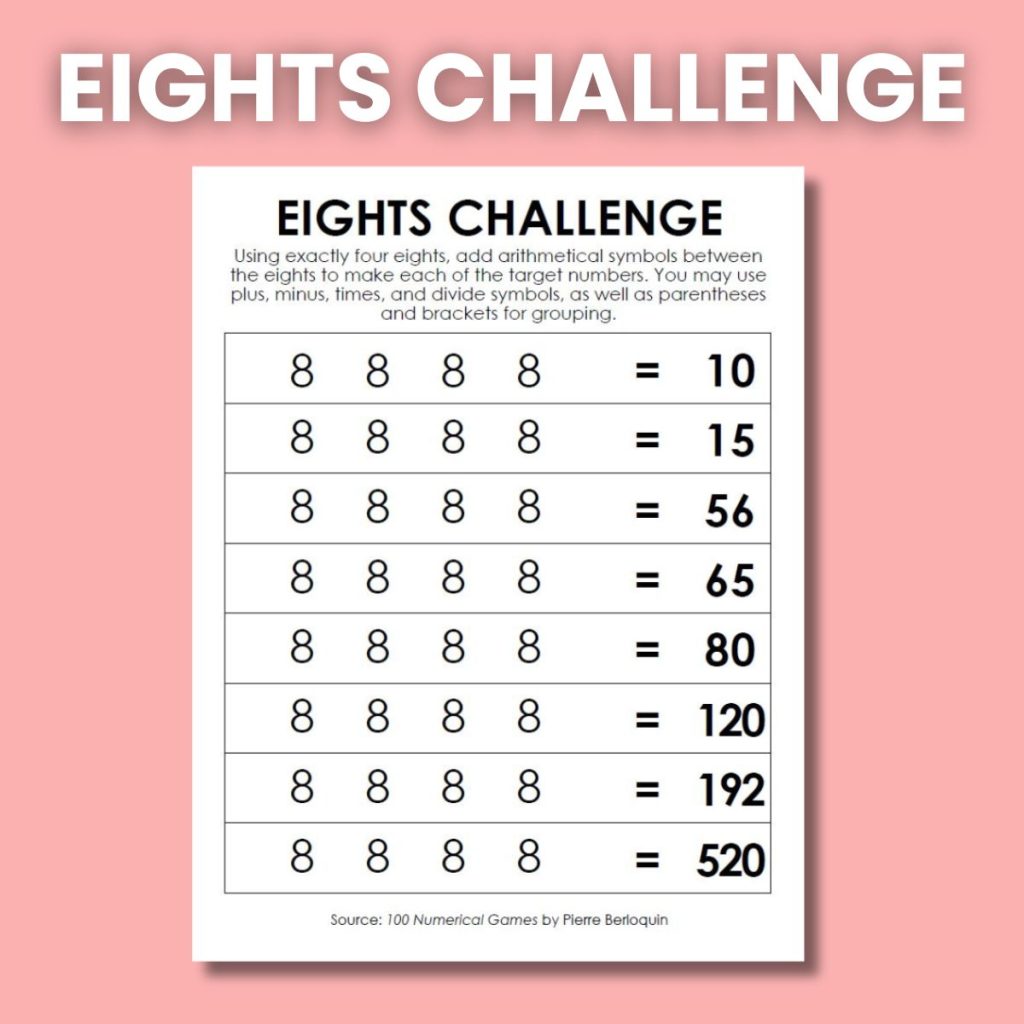
Using exactly four eights, add arithmetical symbols between the threes to make each of the target numbers. You may use plus, minus, times, and divide symbols, as well as parentheses and brackets for grouping.
Nines Challenge
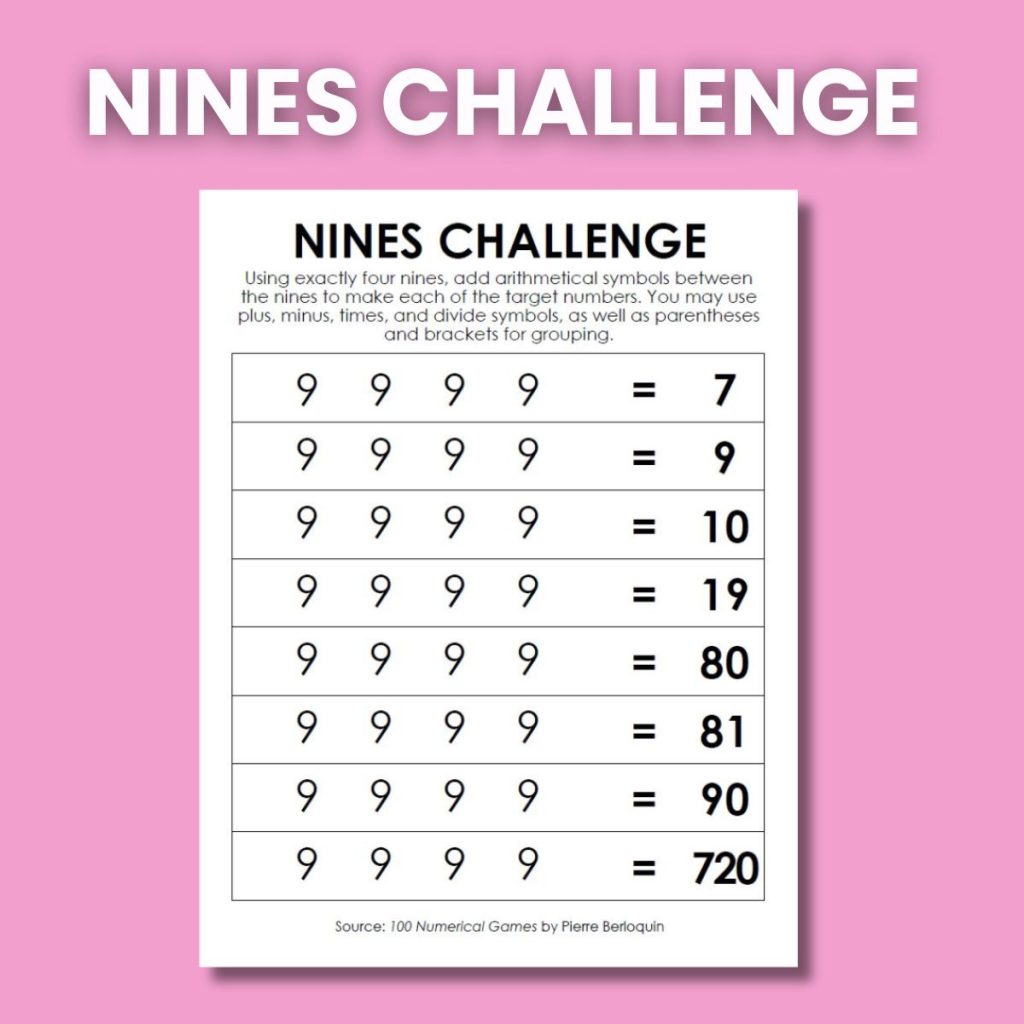
Using exactly four nines, add arithmetical symbols between the threes to make each of the target numbers. You may use plus, minus, times, and divide symbols, as well as parentheses and brackets for grouping.
Digital Adaptations of the Twos to Nines Challenge
Google Slides
The Twos to Nines Challenge has been turned into a Google Slides activity by Meghan Smeenk. Check it out here.
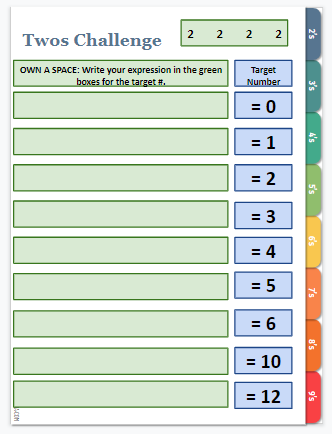
KellyLove shares a slightly different Google Slides version.
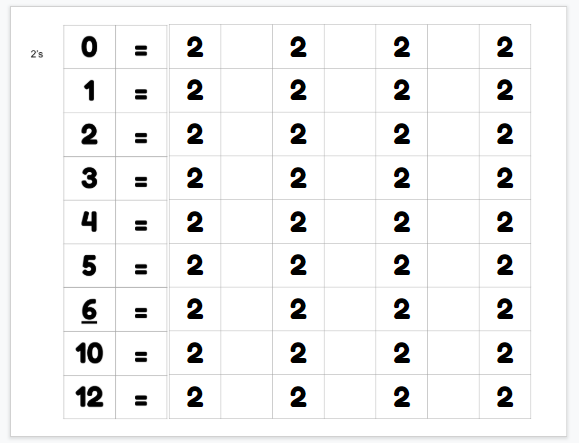
Desmos Activity Builder
Scott McEwen has created Amplify (Desmos) versions of this activity as well. Each challenge is a separate Activity Builder.
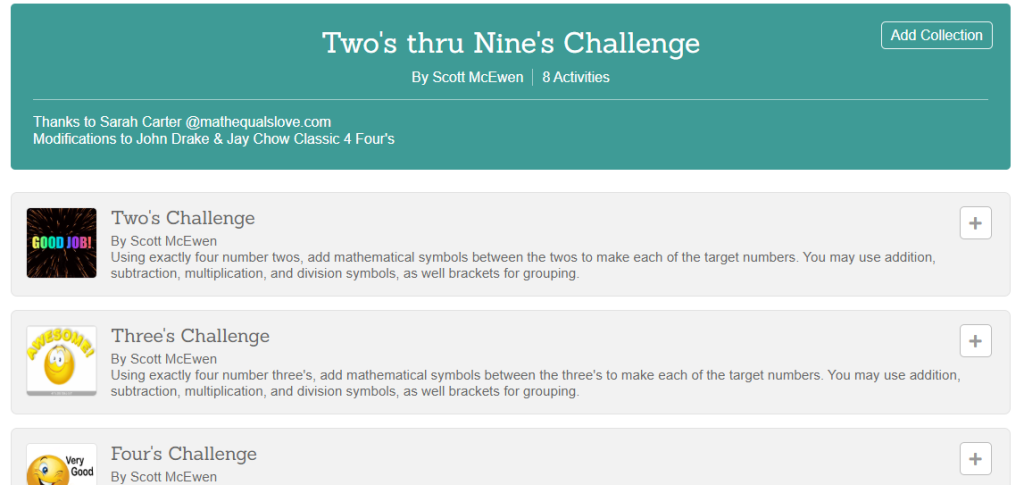
Puzzle Solutions
Puzzle solutions are available on a password-protected solution page. I do not openly post the puzzle answer keys because one of my goals as a resource creator is to craft learning experiences for students that are non-google-able. I want teachers to be able to use these puzzles in their classrooms without the solutions being found easily on the Internet.
Please email me at sarah@mathequalslove.net for the password to the answer key database featuring all of my printable puzzles and math worksheets. I frequently have students emailing me for the answer key, so please specify in your email what school you teach at and what subjects you teach. If you do not provide these details, I will not be able to send you the password.
Not a teacher? Go ahead and send me an email as well. Just let me know what you are using the puzzles for. I am continually in awe of how many people are using these puzzles with scouting groups, with senior adults battling dementia, or as fun activities in their workplace. Just give me enough details so I know you are not a student looking for answers to the puzzle that was assigned as their homework!

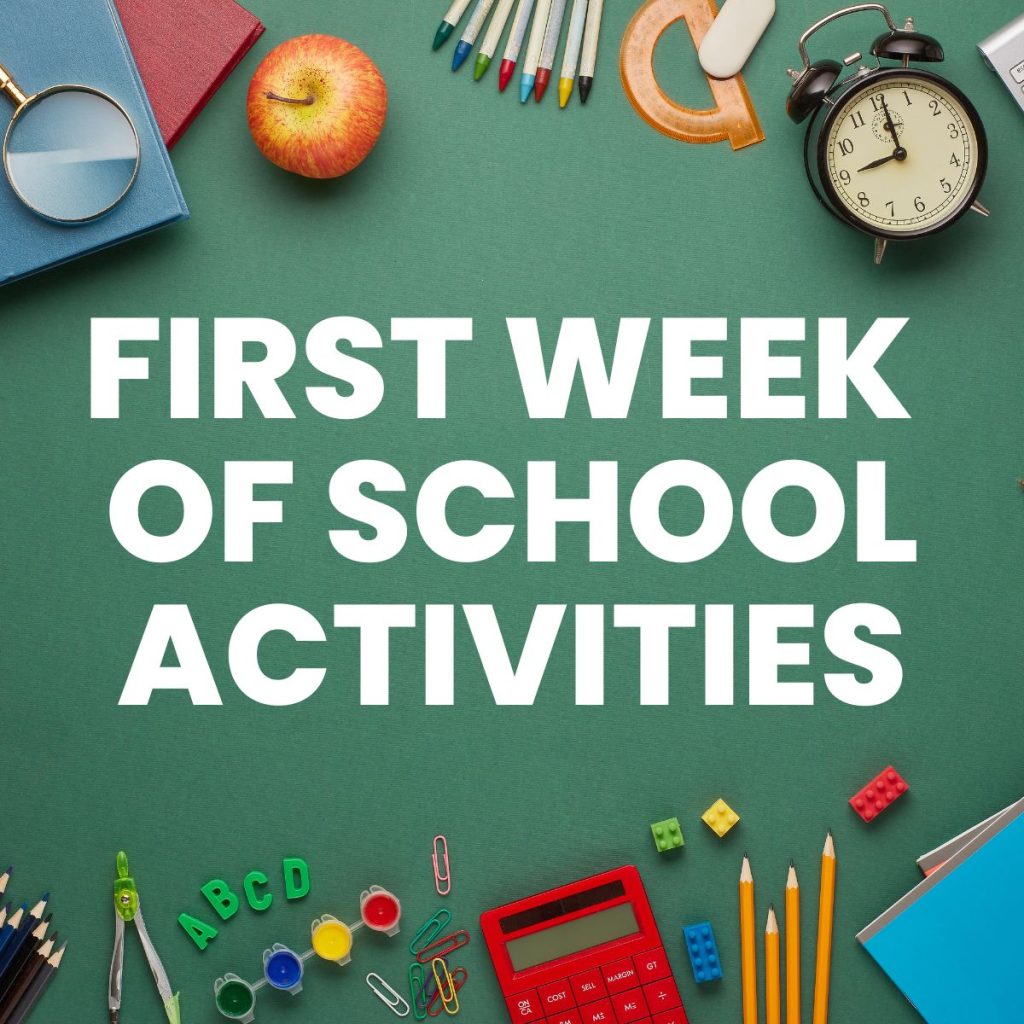


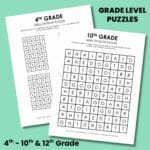
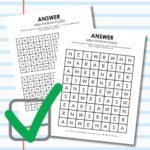
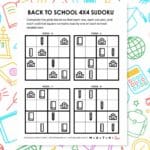

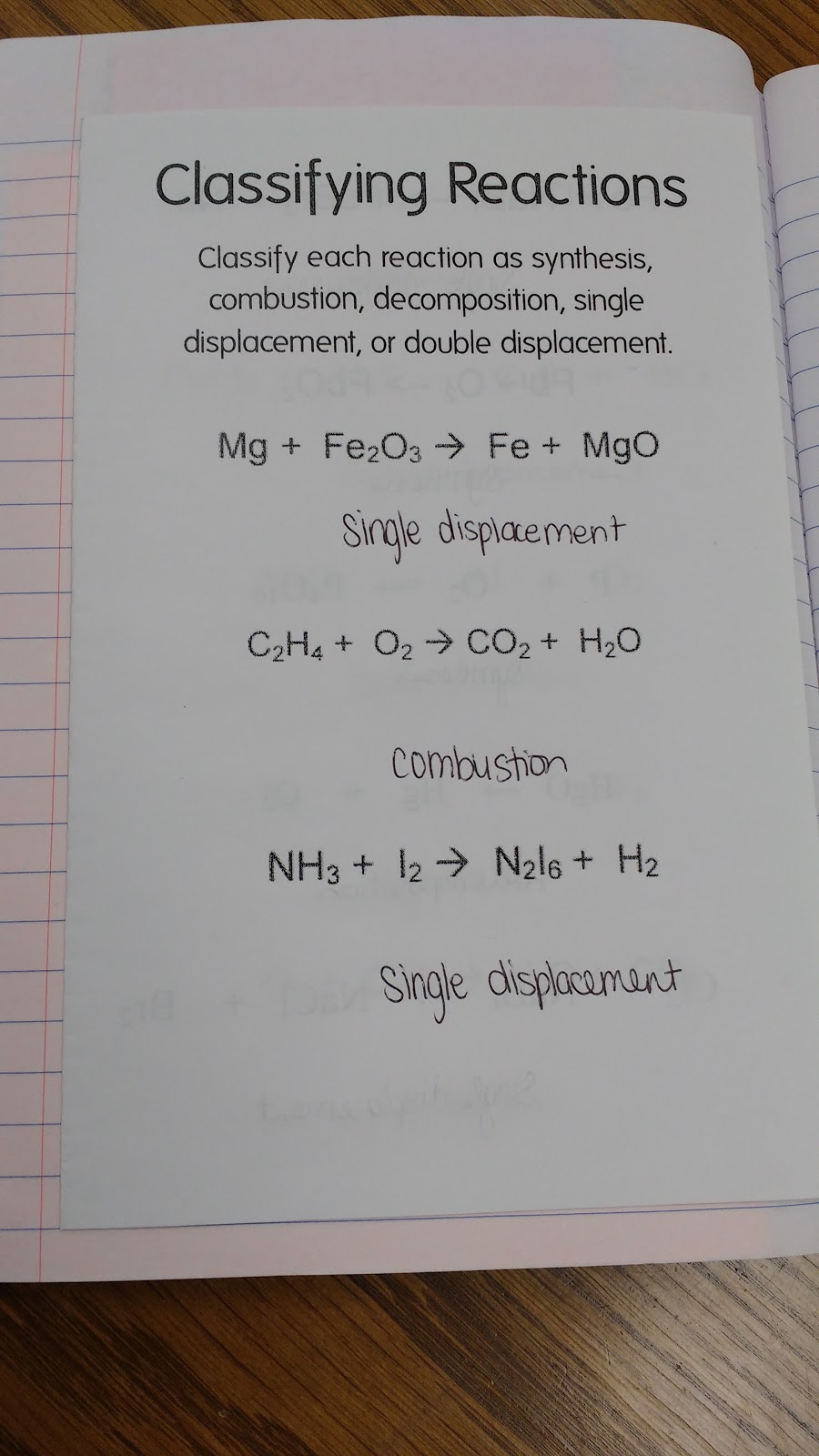
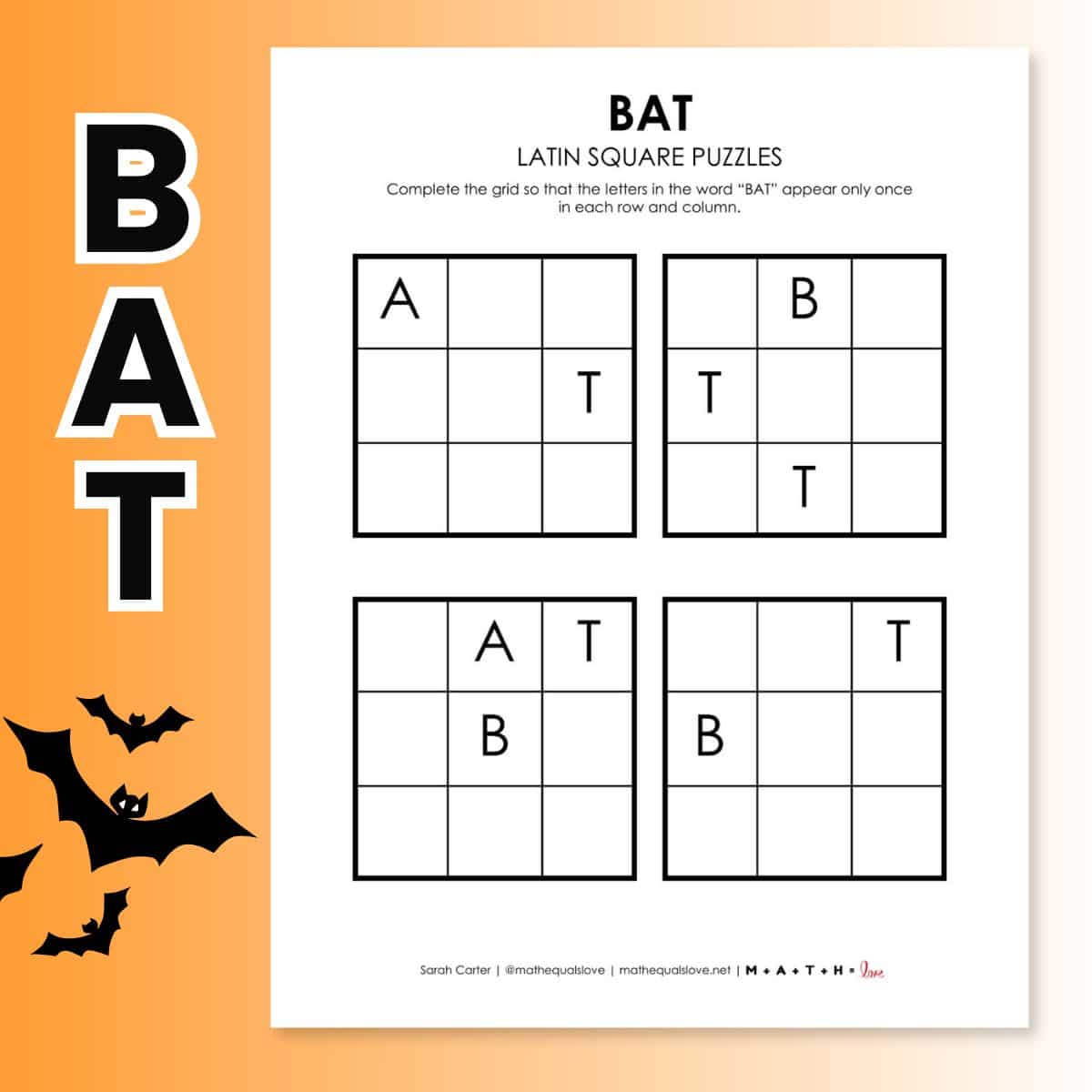
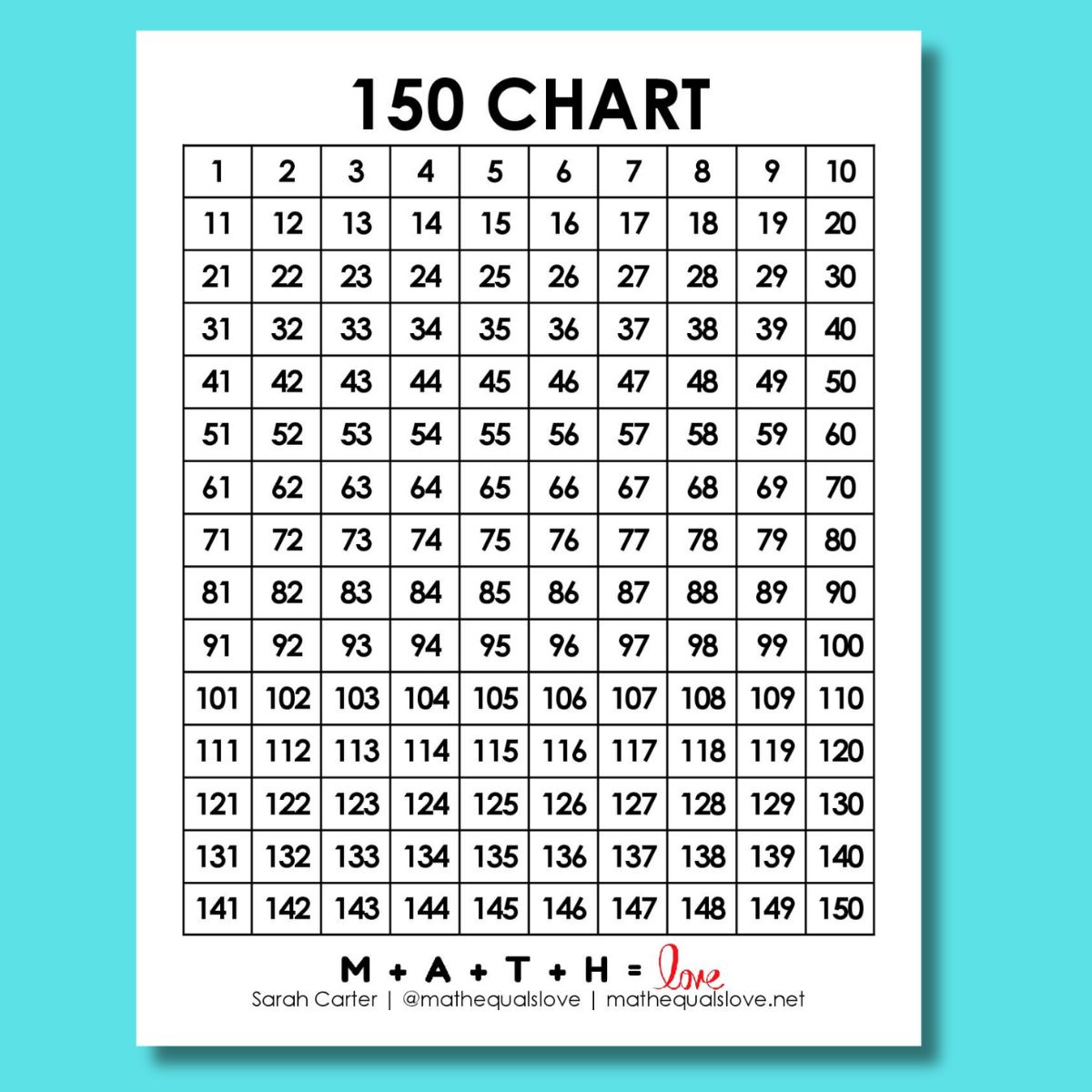
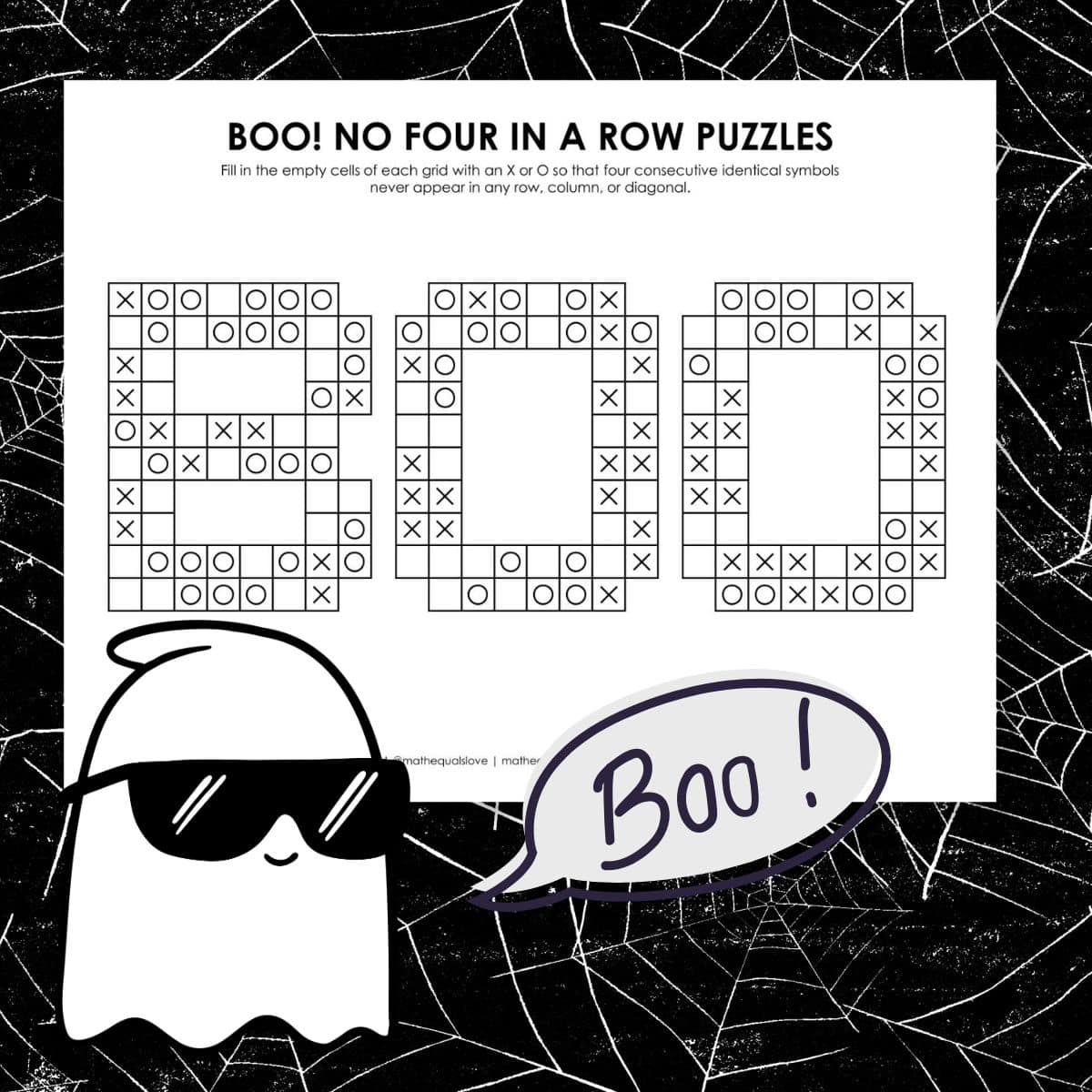
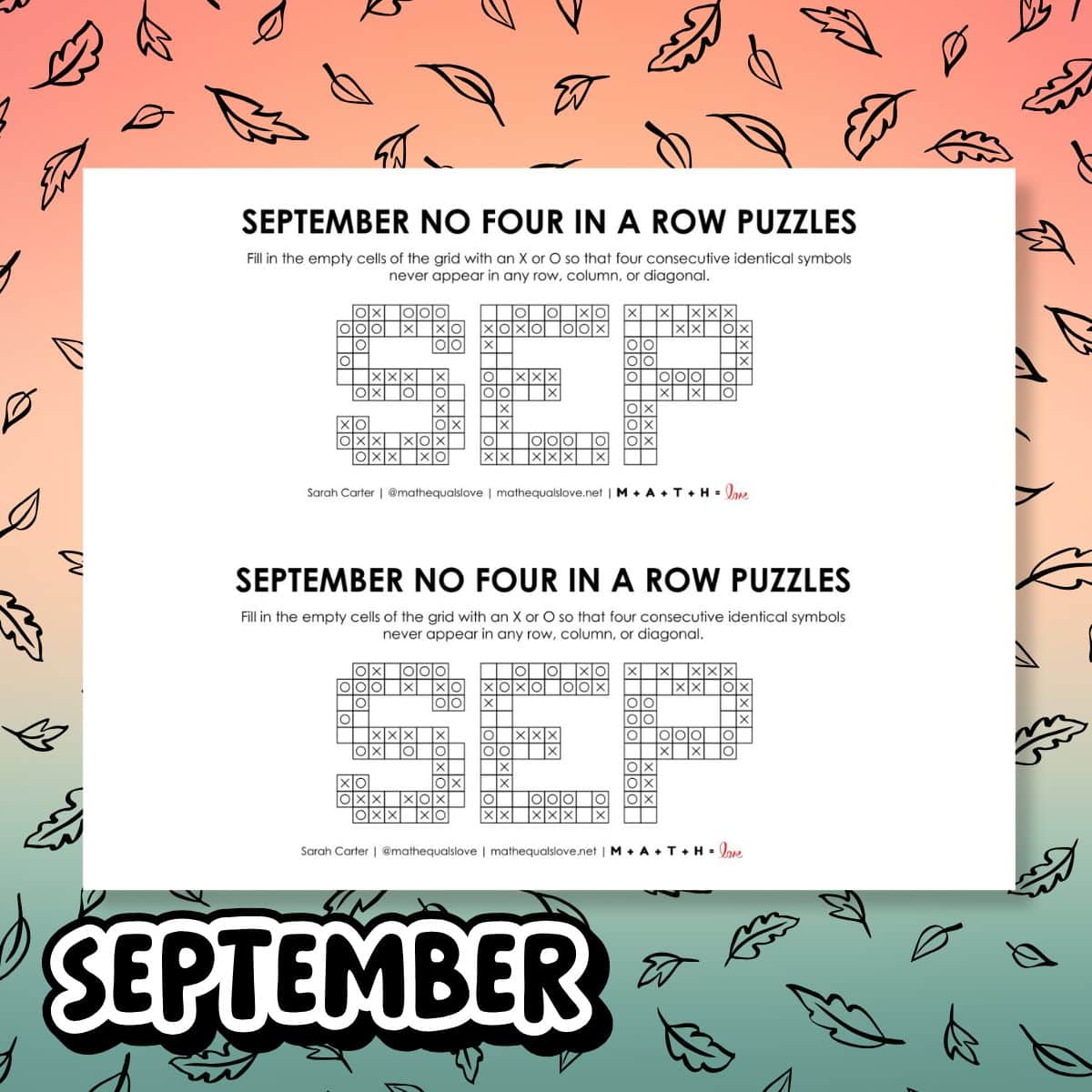
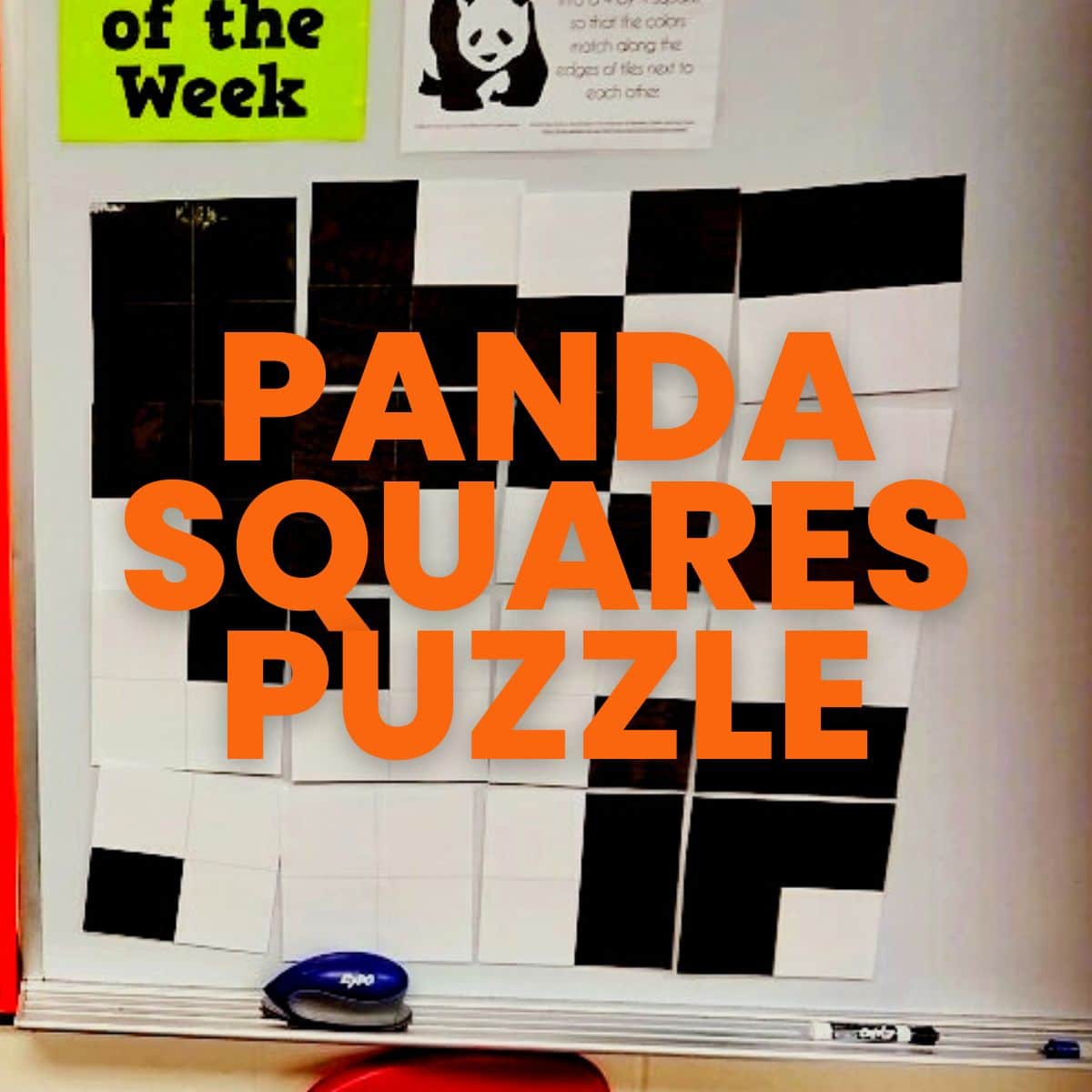
I love it! Glad you're off to a good start! Again, you have me missing math teaching…
Would this be appropriate for a 7th grade class
I plan to try it either the 1st or 2nd day in my 7th grade class.
Definitely using this for my first day tomorrow!
This reminds me of the '24 Game' that I play with my students. It builds great math and thinking skills. At first they're a little slow to figure it out, but they catch on and love it! The math whiz student in the room really loves it, and the other students love to beat the math whiz at solving it first. Here's a link to the game and how it's played.
https://www.24game.com/
https://www.24game.com/t-about-howtoplay.aspx
Used this today with my classes as a First Day activity. My Algebra 1 students especially liked it. Thank you for sharing!
Best Math Puzzle
hi there! just to clarify. did a group work on only one set of numbers? Thank you!
Thanks so much. I might use this as an activity to do when I have a sub after an assessment day.
Is there an answer key available for the two to nine challenge? It is an awesome activity, however, I am even stumped on a few of them… yikes 🙂
What class did you use this for?